
23 Best Personal SWOT Analysis Examples for Students
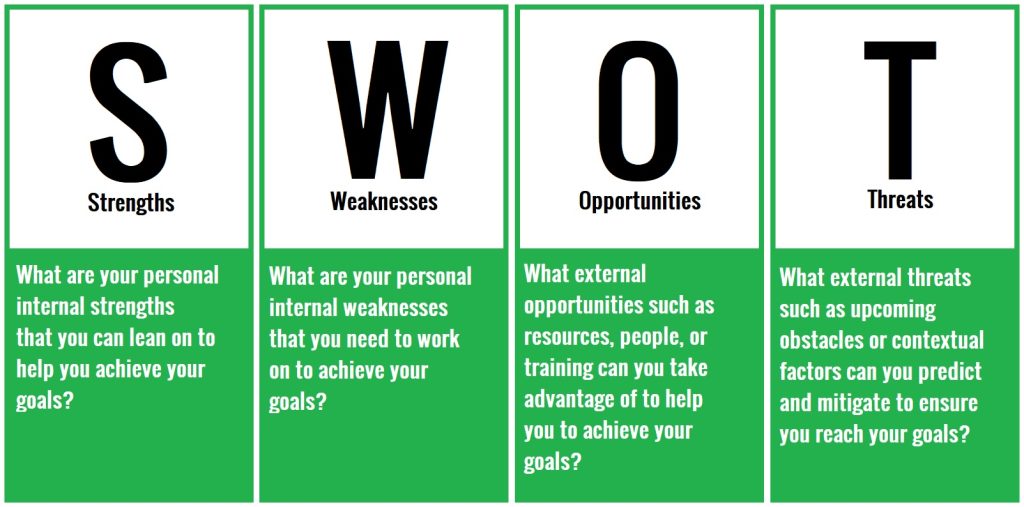
SWOT stands for strengths, weaknesses, opportunities, and threats.
It’s common for students to have a complete mind blank when asked to write a SWOT analysis. It can be hard to step back and objectively figure out what to place in each box in the analysis matrix.
However, by looking at some examples from other students, you can start to conceptualize what’s expected of you and even find yourself agreeing with some of their points.
Take a look at these personal SWOT analysis examples and see if you can cherrypick some key points that might resonate with you.
Pick and choose the points that resonate most with you so you can create your own unique SWOT chart.
Personal SWOT Analysis Examples for Students
1. swot analysis template.
Goal: Write down what your goal is.
2. Personal SWOT Analysis Example
Goal: To gain confidence at university.
Read Also: 42 US Colleges With Bear Mascots
3. Academic Writing Example
Goal: To get an A in an essay this semester.
4. New Student Example
Goal: To Get into a Routine and Comfortable on Campus.
5. College Student Example
Goal: To raise my GPA by 0.5 this year.
6. International Student Example
Goal: To gain confidence in a new society and develop cultural competencies.
7. Education Student Example
Goal: To develop skills and knowledge in teaching.
8. Sociology Student Example
Goal: To figure out how to use my sociology degree to get a career job.
9. Bachelor of Arts Student Example
Goal: To figure out what I want my major to be
10. High School Student Example
Goal: To develop the skills that I’ll need at college next year
11. Math and Science Example
Goal: To get a job in the science field following graduation.
12. Digital Marketing Example
Goal: To improve my skills in digital marketing while still at university.
13. Masters Degree Example
Goal: To complete my masters degree within 3 years
14. Business Student Example
Goal: To gain the skills I need to start my own business in the future.
15. Nursing Student Example
Goal: To get a job in nursing after I graduate with a good GPA.
16. Teacher Example
Goal: To gradually improve my pedagogical competencies in the next 12 months.
17. PhD Student Example
Goal: To make it through the first year of doing a PhD.
18. Internship or Practicum Example
Goal: To grow my confidence in a workplace situation and see if I like this career path.
19. Exchange Student Example
Goal: To broaden my horizons for an exchange semester.
20. Thesis or Dissertation Example
Goal: To get a high grade for my dissertation.
21. Teamwork and Groupwork Example
Goal: To complete our team project and get the best grade in the class.
22. Psychology Student Example
Goal: To get a career in clinical psychology.
23. Graduating Student Example
Goal: To smoothly transition into an entry-level position in my career choice
What does SWOT Analysis Stand For?
SWOT stands for strengths, weaknesses, opportunities, and threats. These are the four key categories that you need to look at to develop an action plan for improving your skills as a student.
Under each column think about what you will write:
- Strengths: What are you aware that you’re good at right now? Make sure it’s relevant to your goal. For example, if your goal is to gain confidence at university, make it relevant to that and not something completely different (being really good at hotdog eating contexts is irrelevant to becoming a more confident student!)
- Weaknesses: What do you struggle with right now? Again, keep it relevant to your goal. If your goal is to get an A in your next paper, reflect on your weaknesses in essay writing.
- Opportunities: What can you think of that might be a valuable resource, support network, or another type of opportunity that can help you to meet your state goal?
- Threats: What can you think of that might make it hard to meet your goals? It’s good to know these so you can prepare ahead and minimize the chance that they will become major obstacles.
What is the Purpose of a SWOT Analysis?
The point of the SWOT analysis is to get you thinking about how you can prepare for improvement. If you know your weaknesses, opportunities, and potential challenges, you can work on the weaknesses, embrace the opportunities, and avert the threats. This will help you get closer to your goals.
Another alternative type of reflective analysis is the Johari Window , which is best completed in teams where your team members can provide input for you.
How to Do a SWOT Analysis
What to write for strengths.
When writing about strengths on a SWOT Analysis, you want to write about things that you’re personally good at.
These strengths are ‘internal’, meaning they’re features about you that make you good at things. They’re things under your direct control.
One problem students come across is that they don’t focus on strengths that are relevant to your goals . So, focus on strengths that can help you achieve your goals.
Key considerations when writing about strengths include:
- What do you do well (in relation to your goal)?
- What study skills do you currently have?
- What academic writing and research skills do you currently have?
- What workforce skills do you currently have?
- What soft skills do you currently have?
- What hard skills do you currently have?
We have a list of 110 strength examples for a SWOT analysis that you can browse to find ones that work for you.
What to Write for Weaknesses
When writing about weaknesses on a SWOT Analysis, you want to write about things that you’re personally not very good at.
These weaknesses are ‘internal’, meaning they’re features about you that you know are not your strongest trait. Like strengths, these weaknesses need to be things under your direct control.
Remember ot keep them relevant to your goals . So, focus on weaknesses that might prevent you from achieving your goals.
Key considerations when writing about weaknesses include:
- What do you think you’re not very good at (in relation to your goal)?
- What do you struggle with when studying?
- What are your weaknesses in regards to academic writing and researching?
- What workforce readiness skills do you lack?
- What soft skills do you lack?
- What hard skills do you lack?
We have a list of 79 weaknesses examples for a SWOT analysis that you can browse to find ones that work for you.
What to Write for Opportunities
When writing about opportunities on a SWOT Analysis, you want to write about things that you can rely on to help you reach your goals.
These opportunities are ‘external’, meaning they’re not personal features about you, but resources, people, or events that you turn to for help.
Again, remember to talk about opportunities that are relevant to your goals .
Key considerations when writing about opportunities include:
- Are there upcoming seminars, classes, or lectures that can help you improve?
- Do you have access to resources to help you improve?
- Do you have access to people or friends who can help you out?
We have a list of 61 opportunity examples for a SWOT analysis that you can browse to find ones that work for you.
What to Write for Threats
When writing about threats on a SWOT Analysis, you want to write about things that are outside of your direct control that might interfere with you achieving your goals.
These external threats are examined so you can predict them and think about ways to either avoid or mitigate their effects.
Remember to talk about threats that are relevant to your goals .
Key considerations when writing about threats include:
- What contextual factors might get in the way of your goals?
- What obstacles can you predict that might interfere with your plans?
- What resources do you lack that would otherwise be helpful?
A SWOT analysis is designed to get you thinking about how to use your personal strengths and opportunities to your advantage, while also improving your weaknesses and mitigating threats that you can predict.
While these examples can help get you mind turning, remember that your SWOT Analysis needs to be unique to you. So, use these personal SWOT analysis examples by students to get your mind turning, but write your own unique SWOT matrix that’s an honest reflection of your own situation.

Chris Drew (PhD)
Dr. Chris Drew is the founder of the Helpful Professor. He holds a PhD in education and has published over 20 articles in scholarly journals. He is the former editor of the Journal of Learning Development in Higher Education. [Image Descriptor: Photo of Chris]
- Chris Drew (PhD) https://helpfulprofessor.com/author/chris-drew-phd/ 5 Top Tips for Succeeding at University
- Chris Drew (PhD) https://helpfulprofessor.com/author/chris-drew-phd/ 50 Durable Goods Examples
- Chris Drew (PhD) https://helpfulprofessor.com/author/chris-drew-phd/ 100 Consumer Goods Examples
- Chris Drew (PhD) https://helpfulprofessor.com/author/chris-drew-phd/ 30 Globalization Pros and Cons
2 thoughts on “23 Best Personal SWOT Analysis Examples for Students”
Dr Chris… Excellent article and it was really helpful for me to set SWOT analysis for my students. The content of the article is highly useful and practical too to adopt for educational institutions. Thank You Dr Shyam prasad TS Asst Prof, RV Institute of legal studies , Bengaluru, India [email protected]
Thank you so much for the detailed SWOT for my learners.
Leave a Comment Cancel Reply
Your email address will not be published. Required fields are marked *
- Top Colleges
- Top Courses
- Entrance Exams
- Admission 2024
- Study Abroad
- Study in Canada
- Study in UK
- Study in USA
- Study in Australia
- Study in Germany
- IELTS Material
- Scholarships
- Sarkari Exam
- Visual Stories
- Write a review
- Login/ Register
- Login / Register
SWOT Analysis for Students: How to Write, Examples

Pallavi Pradeep Purbey ,
Mar 4, 2024
Share it on:
SWOT analysis for a student indicates the domains in which they are strong and the areas of improvement. A student can analyze what opportunities lie ahead of them through SWOT analysis and can also figure out what possible obstacles might arise.

SWOT analysis for students is an assessment method in which students identify their areas of weakness in order to strengthen their areas of strength, it helps students achieve a clear picture of where they stand. The SWOT's full form is Strengths, Weaknesses, Opportunities, and Threats.
Performing a SWOT analysis will make them face reality. The next course of action can be influenced by these four forces as lack of fundamental skills frequently traps students, whether they are pursuing further education or a career.
Further, they get a chance to know what their goal is and where they currently stand. Besides, it also helps students to identify areas of improvement and goal settings.
Table of Contents
What is SWOT Analysis for Students?
Examples of swot analysis, importance of swot analysis, how to write swot analysis for students, uses of swot analysis for students.
SWOT stands for Strengths, Weaknesses, Opportunities, and Threats. SWOT analysis for a student implies the parts they are good at and factors that need improvement.
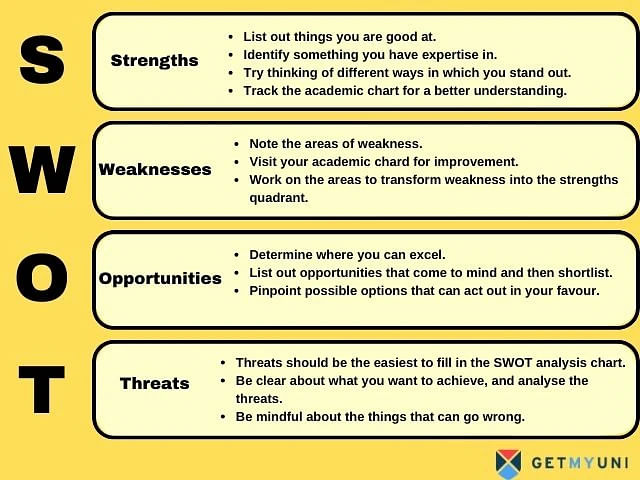
Let us break down SWOT analysis and see what each quadrant of SWOT indicates.
Opportunities
The strength quadrant indicates the following in the SWOT analysis.
- List out things you are good at.
- Identifying things you know will help when you have a problem.
- Try thinking of different ways in which you stand out from the crowd.
- Track the academic chart for a better understanding.
The following weakness quadrant are recognised through the SWOT analysis.
- Note the areas where there is a scope of improvement.
- Visiting your academic chard for this part of the SWOT analysis will be fruitful.
- Identifying what you need to move or improve from weakness to the strengths quadrant.
The opportunities quadrant of SWOT analysis for students reveals the following.
- After identifying strengths and areas for improvement, you can identify where you can excel.
- List out opportunities that come to mind and then shortlist.
- Do not be too specific and list as many as you think you can achieve.
- Identify possible or different opportunities around you that can act out in your favour.
The threats quadrant of of SWOT analysis for students indicates the following.
- Threats should be the easiest to fill in the SWOT analysis chart.
- It is clear what you want to achieve by now, and you also know what could go wrong.
- List out things that might come in the way of your goals.
- Also, write about what scares you the most and the demotivating factor.
Also Read: Smarter Study Tips for Students to Ace Their Management Exams
Through SWOT analysis, a student can analyse what opportunities lie ahead of them. Here are a few of SWOT analysis examples for students.
SWOT Analysis Example - Strengths
The strength quadrant of SWOT analysis examples for students brings out the following:
- What are my strengths? – “I have strong communication skills, efficiency with technology”
- In which subject do I score well? – English and Mathematics.
- Which is my favourite subject? – Basketball
- What do others see as my strengths? – “They feel I am open to new ideas.”
- What are my hobbies and interests? – “I love to paint abstract, do indian classical dance or I play the guitar.”
SWOT Analysis Example - Weaknesses
The weakness of SWOT analysis examples for students discloses the following:
- What is my weakness? - Easily distracted and get nervous at interviews
- Which is the subject that I struggle with? – Physics
- Which is my least favourite subject? - Geography
- In which areas, I need more education or skill-based training? – “I need to learn coding and search engine optimization.”
- What are my negative traits or habits? – Impatience and procrastination
SWOT Analysis Example - Opportunities
The SWOT analysis opportunities examples for students are as mentioned below:
- What opportunities are open to me? - “I have studied Science in class 12 which opens career avenues for Commerce and Arts too for me.”
- What are the strengths that I can turn into opportunities? – “I like to stay fit so I could appear for Defence services exams.”
SWOT Analysis Example - Threats
The examples of threats SWOT analysis for students are as pointed out below:
- What are the threats that could affect my chosen career field? – “The number of seats are limited in the university that I am applying to.”
- What scares me the most and is the demotivating factor? – “I have to appear for entrance exams which I am scared of, but it's the only way to get admission into good engineering colleges.”
Also Read: Toppers Time Table for Class 12th: Your Key to Academic Excellence
Doing a SWOT analysis for students will help figure out the shortcomings and provide a clearer picture of the goals. The importance of performing a student SWOT analysis are as follows.
- Making correct decisions for exploring various opportunities.
- Having a clear understanding of your goals.
- Making changes in the plan to accommodate possibilities.
- Understanding choices to counteract threats.
- It keeps you aware of the shortcomings and acts as a motivation.
- Help in utilizing available resources to the best of your ability.
- Reviewing options and prioritizing accordingly.
There are many advantages of performing SWOT analysis as a student. The significance of the SWOT analysis may vary depending on one's goals.
Also Check : Top 10 Most Effective Stress Management Techniques for Students
The first step to perform after understanding the SWOT analysis and its significance is to do academic research. While doing a SWOT analysis, students need not follow the same order of identifying strengths first, then weaknesses.
Here is a process that students can follow to start.
- Identify Goals
- Identify Strengths and Weaknesses
- Identify Opportunities
- Identify Threats
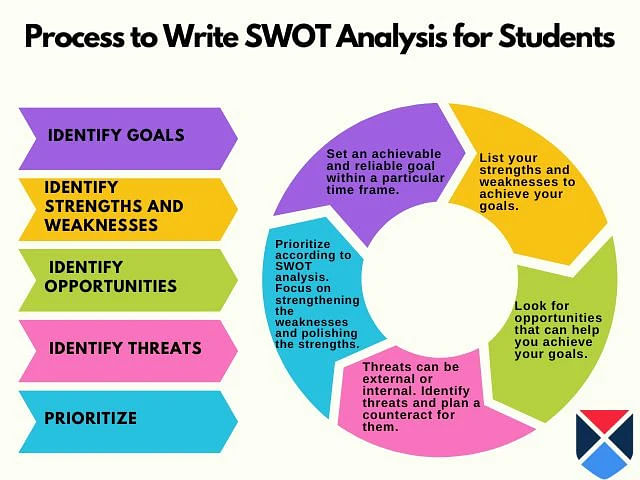
1. Identify Goals
The primary step is to identify the end goal. While doing it, the student must be fully aware of what they are working towards to achieve it.
The goal set must be achievable, reliable, and with a particular time frame. Having dreams with no deadline to accomplish will leave you feeling lazy.
Achievable goals are always better than one long-term goal somewhere in the distant future.
2. Identify Strengths and Weaknesses
Now that you have defined goals for yourself, list down the strengths and weaknesses to help or prevent you from achieving them.
It is true that only you know yourself better, so writing down the strengths and weaknesses relating to a goal should not be a task.
In case you are unsure, you can always consult a friend or a mentor to assist with your strong and weak points.
3. Identify Opportunities
List down things that you think will enable you to achieve your goals faster. These are usually external factors that you can leverage for yourself to move ahead in your career.
Only if you're clear on your plan can you identify an opportunity that will help you move closer to accomplishing your aim.
4. Identify Threats
Threats are a superset of weaknesses that you contemplated for your SWOT analysis. Threats, however, can be external or internal.
Since we covered internal threats in the weakness quadrant of SWOT, here list down external threats. These threats will act as obstacles between you and your objective.
Only if you would have identified threats clearly, can you plan a counteract for them.
5. Prioritize
By now, you should be able to complete the academic SWOT analysis. Once complete, review the probe and make changes if required.
Viewing the SWOT should give you a clear understanding of what you need to prioritize. Next, look at all four areas of the SWOT analysis and start working towards your goal accordingly.
Also Check : 10 Tips for Staying Focused and Productive as A Student
Since students are aware of the SWOT analysis, its importance, and how we write it. Let us now see the uses of an academic SWOT analysis.
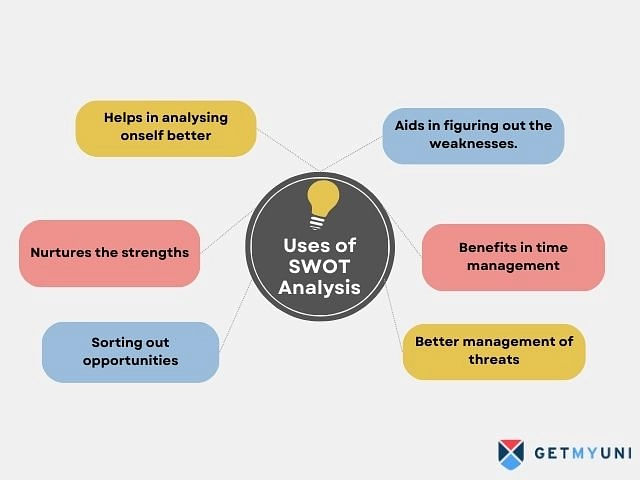
Below are the uses of student SWOT analysis.
- Understanding yourself better
- Building on strengths
- Eradicating weaknesses
- Leveraging opportunities
- Counteracting threats
- Time management
- Jumping from one completed goal to another
With the SWOT analysis help, students would have identified their vital areas and know what needs more work. So, pick up a pen now and make the road to your future a lot smoother.
Also Check: 10 Healthy Habits for Students to Excel in Studies
What are the strengths and weaknesses of a student?
What are my threats as a student?
What is a SWOT analysis of myself?
What are the opportunities and threats?
POST YOUR COMMENT
Related articles.

Top 10 AKTU Colleges 2024: Check Courses, Duration, Fees

Skill Development Courses List for Students 2024

TDB College Merit List 2024: Dates, Admission List

IGNOU Courses after 12th 2024 - Bachelors, Diploma & Certificate

List of MHT CET Colleges with Institutional Code 2024

MHT CET Career Options 2024: Courses, Top Colleges

How to Study Physics for MHT CET 2024? Tips, Marking Scheme
Get Free Scholarship worth 25000 INR
Master the Art of Writing an Impressive Swot Analysis Essay

Are you struggling with how to get started with your recent assignment of writing a swot analysis essay? It sure is a tough ask from students dealing with such an essay for the first time.
But you don’t have to worry as this blog post serves as a comprehensive guide to help students grasp the fundamentals of writing a SWOT analysis essay. It breaks down the intricate components, providing a step-by-step approach that simplifies understanding and implementation for learners.
As you should know. the swot analysis essay has four crucial elements, such as strengths, weaknesses, opportunities, and threats. The strengths and weaknesses pertain to internal aspects, focusing on what an entity excels at and where it lacks. Opportunities and threats, on the other hand, address external factors, exploring potential avenues for growth and the challenges that may hinder progress.
This blog post is filled with amazing guidelines from professional paper writers . Hence, it’s an opportunity even for new students to master some tricks and tips for writing a good swot analysis essay.
Table of Contents
What is a Swot Analysis?
A SWOT analysis is a strategic tool used by organizations to evaluate their internal strengths and weaknesses alongside external opportunities and threats. It’s all about looking at the good and bad stuff inside the organization and the good and bad stuff outside of it, to get a clear picture of where things are at and where they could go in the future. This analysis is super helpful for coming up with plans, making smart choices, and using the good stuff to deal with any weaknesses or outside threats.
The importance of a SWOT analysis lies in its ability to provide a clear overview of an organization’s or project’s current state, facilitating better strategic planning and decision-making. By identifying strengths and weaknesses, an organization can leverage its advantages while addressing areas that require improvement. Furthermore, recognizing external opportunities allows for proactive steps to capitalize on them, while acknowledging threats helps in developing contingency plans to minimize their impact. Overall, conducting a swot analysis enables a more focused and informed approach toward achieving goals and maintaining competitiveness.
For students seeking assistance in crafting a swot analysis essay or assignment, relying on professional paper writing help can be beneficial. Expert writers can offer guidance on structuring the analysis, gathering relevant data, and ensuring a comprehensive evaluation of the subject matter.
Why Should Students Learn to Write a Swot Analysis Essay?
Learning to write a SWOT analysis essay equips students with valuable skills applicable across various fields and industries. Understanding how to conduct a SWOT analysis develops critical thinking, analytical, and decision-making abilities. It enables students to assess an organization’s or a project’s strengths, weaknesses, opportunities, and threats, fostering a deeper comprehension of strategic planning and evaluation.
Mastering the skill of writing a SWOT analysis essay allows students to:
Develop Analytical Skills
Analyzing internal and external factors cultivates a structured approach to problem-solving and decision-making. This skill is transferable to many scenarios beyond business settings.
Enhance Strategic Thinking
Recognizing and evaluating strengths, weaknesses, opportunities, and threats fosters strategic thinking. It encourages students to consider multiple perspectives and anticipate potential outcomes, which is vital in making informed decisions.
Improve Communication
Writing a SWOT analysis essay involves organizing thoughts and presenting information coherently. This skill enhances communication abilities, allowing students to convey complex ideas effectively.
Prepare for Real-world Applications
SWOT analysis is widely used in business, marketing, project management, and other fields. Acquiring proficiency in this area prepares students for future professional endeavors where strategic evaluation and planning are crucial.
Steps to Writing a Good Swot Analysis Essay
Here’s a step-by-step approach to learning how to write a swot analysis essay that even the experts working with the most experienced coursework writing service would follow.
Step 1: Choose a Subject
Select an organization, a project, a product, or a specific situation to analyze. Clearly define the scope and objectives of your analysis.
Step 2: Identify Strengths
- List the internal factors that give the subject a competitive advantage or positive attributes.
- Consider unique resources, skills, market position, or any other advantageous aspects.
Step 3: Pinpoint Weaknesses
- Evaluate internal factors that hinder the subject’s performance or pose challenges.
- Identify areas for improvement such as lack of resources, inefficient processes, or any other internal limitations.
Step 4: Explore Opportunities
- Analyze external factors that could positively impact the subject.
- Look for emerging trends, market shifts, technological advancements, or any other external opportunities that can be leveraged.
Step 5: Assess Threats
- Identify external factors that could potentially harm the subject’s success.
- Consider competition, economic factors, regulatory changes, or any other external threats that could negatively impact the subject.
Step 6: Organize the Information
Create a structured format to present your analysis. This could be a table, a matrix, or a written narrative divided into sections for strengths, weaknesses, opportunities, and threats.
Step 7: Analyze Relationships
Explore how strengths can counteract weaknesses or how opportunities can offset threats. Highlight connections between internal and external factors.
Step 8: Provide Examples and Evidence
Support each point with specific examples, data, or anecdotes to strengthen your analysis and provide credibility to your arguments.
Step 9: Formulate Recommendations
Based on the analysis, propose strategies or actions to capitalize on strengths, address weaknesses, exploit opportunities, and mitigate threats.
Step 10: Conclusion
Summarize the key findings of your SWOT analysis and emphasize the significance of the insights obtained. Conclude with a clear takeaway or recommendation.

How Can Students Get Better at Writing a Swot Analysis Essay?
Students can enhance their skills in writing a SWOT analysis essay through several methods:
Practice Regularly
Engage in consistent practice by analyzing various subjects using the SWOT framework. This repetition hones analytical skills and strengthens the ability to identify relevant factors.
Study Examples
Review a well-written swot analysis paper example or report to understand the structure, language, and depth of analysis. Analyze how to present a swot analysis and how to conclude it well. Going through examples will also allow you to understand the swot analysis format.
Gather Comprehensive Information
Ensure a thorough understanding of the subject being analyzed. Gather data from reliable sources to support each point in the analysis, enhancing its credibility.
Seek Feedback
Share your SWOT analysis drafts with peers, instructors, or mentors. Constructive feedback helps identify areas for improvement and enhances the quality of the analysis.
Utilize Resources
Utilize academic resources, online materials, textbooks, and guidance from professionals or writing centers to grasp different approaches to conducting and presenting SWOT analyses.
Critical Thinking Development
Practice critical thinking by challenging assumptions, considering alternative perspectives, and evaluating the significance of each factor within the analysis.
Refinement through Revision
Revise and refine the analysis multiple times, focusing on clarity, coherence, and depth. Each revision contributes to a more polished and comprehensive SWOT analysis.
Apply Real-life Scenarios
Practice applying the SWOT framework to real-life situations or current events. This helps in understanding the practical applications of the analysis beyond theoretical knowledge.
Stay Updated
Keep abreast of industry trends, market changes, and relevant developments to conduct a more accurate and up-to-date SWOT analysis.
Time Management
Allocate sufficient time for each phase of the analysis, from research to drafting and revising. Effective time management ensures a more thorough and well-constructed SWOT analysis.
Final Thoughts
In this blog post, we’ve focused on a systematic approach to learn the process of crafting a compelling SWOT analysis essay for students. We wanted to make it easier for students to write a good swot analysis essay, so we broke it down into clear steps. Our goal was to give them a complete guide that covers everything they need to know. We want students to see how important it is to understand both their own strengths and weaknesses, as well as the opportunities and threats in the outside world. Our approach is all about teaching them the skills they need to make smart decisions and plan strategically.
This guide gives students a step-by-step way to write a SWOT analysis essay. First, you have to choose a topic and figure out what the strengths, weaknesses, opportunities, and threats are. Then, the guide helps you analyze and organize your info. It’s important to connect what’s happening inside and outside the topic when making recommendations. By the end, you’ll have a well-rounded and smart analysis.
For students seeking additional support and guidance in crafting their SWOT analysis essays, our essay writing service provides a valuable resource, enhancing their understanding and proficiency in SWOT analysis writing.
Order Original Papers & Essays
Your First Custom Paper Sample is on Us!
Timely Deliveries
No Plagiarism & AI
100% Refund
Try Our Free Paper Writing Service
Related blogs.

Connections with Writers and support
Privacy and Confidentiality Guarantee
Average Quality Score
How to Write a SWOT Analysis (Template and Examples Included)
#scribendiinc
Written by Scribendi
Planning for the Future
Where do you see yourself in five years? How about your career? Your business?
These questions keep a staggering amount of people awake at night. All too often, the future can seem like a dark, ominous cloud that looms just out of view. As the old proverb goes, we fear the unknown—and little can possibly be more unknowable than the future.
While there is no crystal ball that can accurately predict future market trends or the steps you should take to optimize your productivity and sharpen your competitive edge, we can offer some advice: Reframe the question. Rather than trying to pinpoint where you think you might be in five years, think about where you want to be at that point in time. Once you have a destination in mind, you can start planning a route to get there. After all, maps are great tools, but they can't help you if you don't know where you're going.
So, what's the metaphorical map in this scenario? We present to you the SWOT (strengths, weaknesses, opportunities, and threats) analysis.
How to Write a SWOT Analysis
SWOT analyses are great strategic tools that are useful in project planning, business development , financial strategizing, and personal advancement . Simple, honest, and to-the-point, they facilitate a profound understanding of your or your business's current standing. Essentially, a SWOT analysis is a comparative list of all your strengths, weaknesses, opportunities, and threats.
There's more power in this process than you might think. You may be only hazily aware of your own strengths and weaknesses. However, thoughtfully recording and reflecting on them creates a thorough, conscious familiarity with both the resources available to you and the obstacles standing in your way. This awareness allows you to map out a path toward your goals with great precision and purpose. Writing a SWOT analysis will help you clearly evaluate whether your goals are feasible according to your resources and needs.
In this guide, we'll break down exactly how to write a SWOT analysis and provide a few examples along the way. Feel free to use our SWOT analysis template, given below, to write your own!
Our SWOT Analysis Template
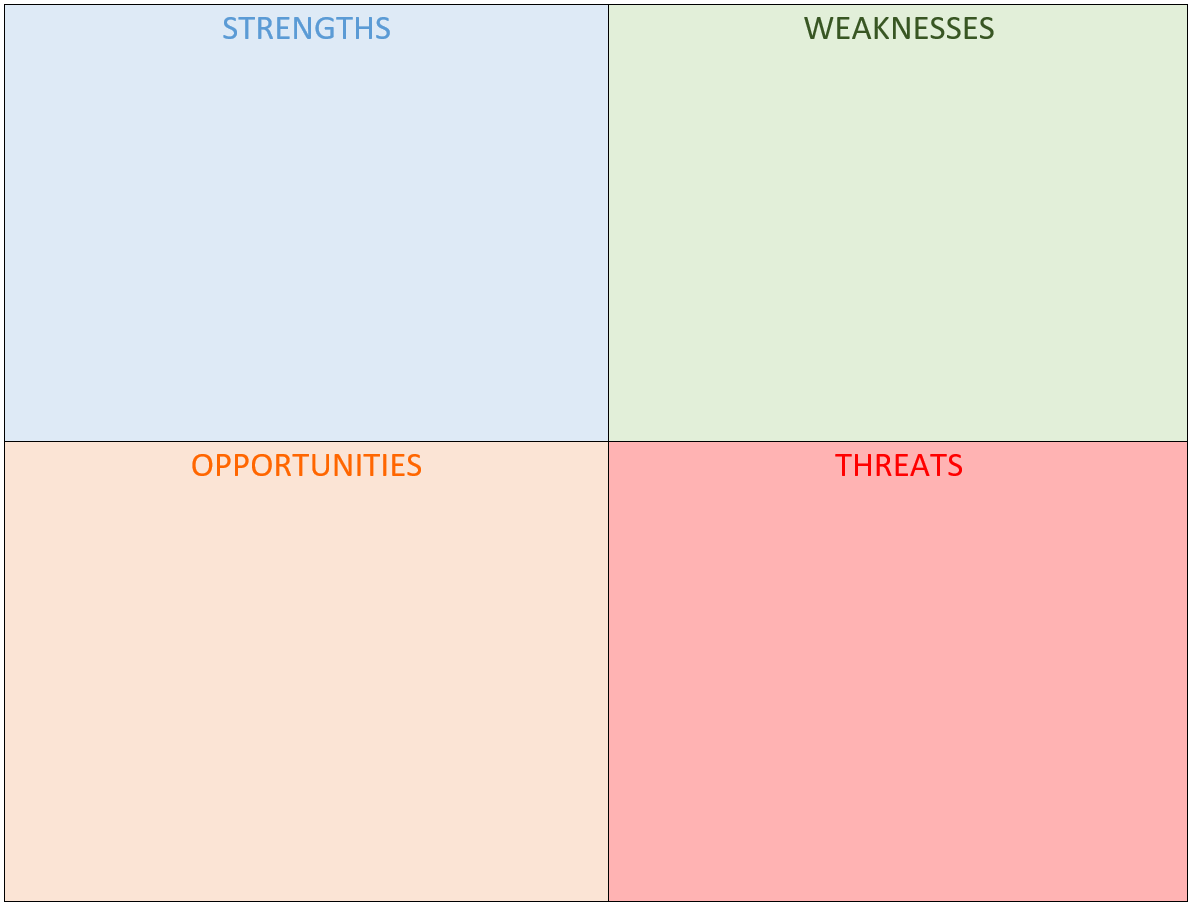
Your list of strengths should focus on your current resources and abilities. It should relate to things that you do or that your company does well. These might be your or your company's accomplishments—both great and small—and the assets that you or your company have. Your strengths give you your greatest edge; they are the resources that propel you forward and that you can continue to develop as you progress.
When you draw up your first SWOT analysis, you may find yourself at a loss. Don't worry—it's difficult for most people to come up with an objective list of strengths and weaknesses on the spot. For your convenience, we've included a list of questions you can ask yourself to get started.
These questions should help you identify a few of your strengths. Remember, while our example questions mostly relate to business strengths, they can also apply to personal strengths. Go ahead and boast as much as you can.
- What sets your company apart from others?
- What do you have that other companies don't?
- What are you most proud of about your company?
- What makes clients come back to you?
- What does your company do well?
- What assets do you have access to?
- What qualities does your company have that other companies try to emulate?
- What has always been easy for your company?
Listing your weaknesses might be a little more uncomfortable than detailing your strengths, but trust us—doing so will help you in the long run. Understanding the obstacles in your path and the elements of your business or skills you may need to improve is just as important as appreciating your strengths. Once you're aware of your weaknesses, you can start working on them and building your next steps around them.
Your list of weaknesses should pertain to any current problems and challenges. Check out the list of questions below—it should give you an idea of where to start. Again, if you'd rather focus on your personal or career growth, feel free to alter these questions to suit your needs.
- What makes your company blend in with its competition?
- What do other companies have that you don't?
- What are the most common criticisms that you receive from clients?
- Why have certain clients not returned to you?
- What does your company need to improve upon?
- What kind of feedback do you receive from your employees?
- What might your competition consider to be a weakness?
- What has always been difficult for your company?
- What are you unwilling to do or change?
Opportunities
Think about the opportunities available to you as potential future strengths. Your opportunities are the assets, resources, and events that could be beneficial to you in some way in the future. You may need to change some of your current approaches or adapt in other ways to capitalize on these opportunities, and that is not necessarily a bad thing.
Here are some questions you can ask yourself to identify your potential opportunities:
- What is happening in the current market that you could capitalize upon?
- What changes have you been making that have returned positive results?
- What is working for other companies?
- How could you introduce new technology to make your processes more efficient?
- What costs can you cut?
- Could you access new sectors or demographic groups?
- How can you improve or modernize your marketing techniques?
- How can you remove existing obstacles?
Threats
Just as your opportunities are based on potential, so are your threats; these are the possible obstacles or issues that are not yet directly affecting your progress. But this doesn't mean that you shouldn't start thinking about them! Being aware of the challenges that you may encounter will help you either plan around them or confront them with solutions. Try to come up with several future events that may realistically hinder the momentum you build from engaging with your strengths and opportunities.
To get started, take a peek at our list of questions:
- What obstacles might your weaknesses create?
- Do changing market trends negatively affect your competitive edge?
- What might stand in the way of the changes you make to accommodate your strengths and opportunities?
- Do you have a lot of debt?
- Could your competition exploit your weaknesses?
How did you do? Do you feel like you've listed everything? Or do you think you're missing something? Below, we've drafted examples of a business and a personal SWOT analysis to provide you with some perspective on what a completed one might look like.
An Example of a Personal SWOT Analysis
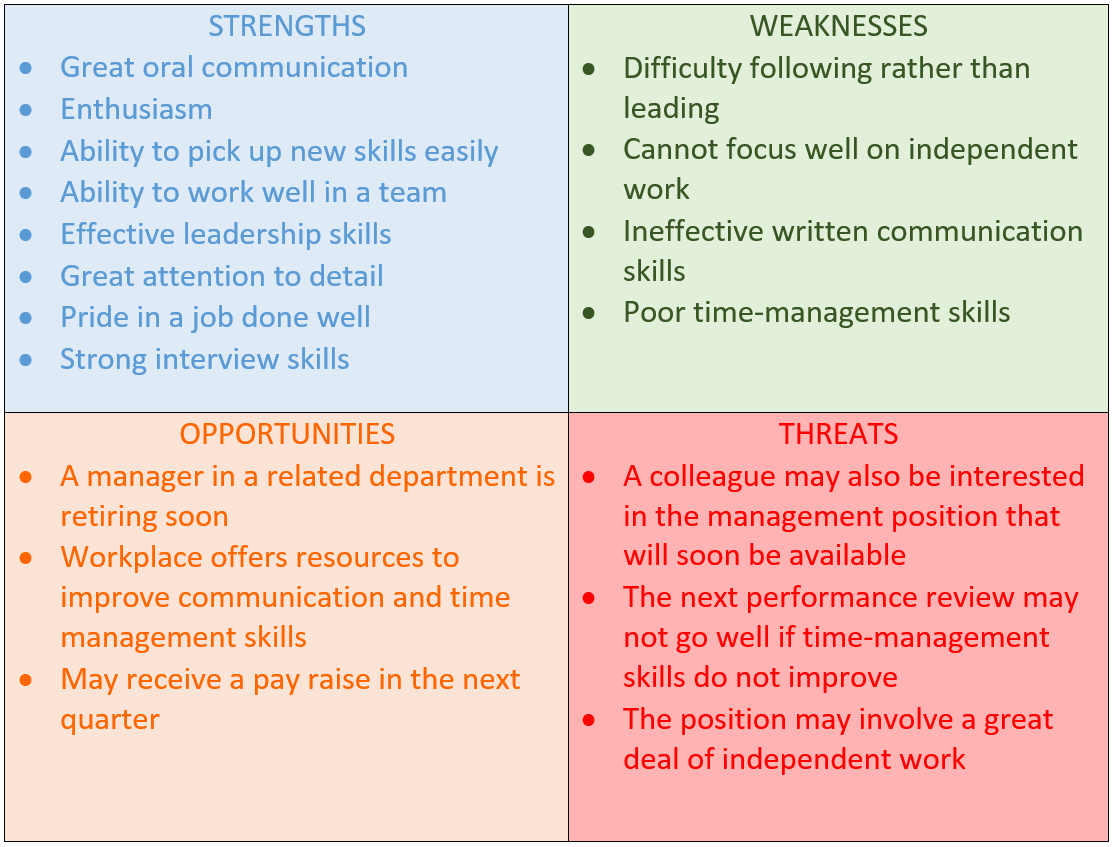
An Example of a Business SWOT Analysis
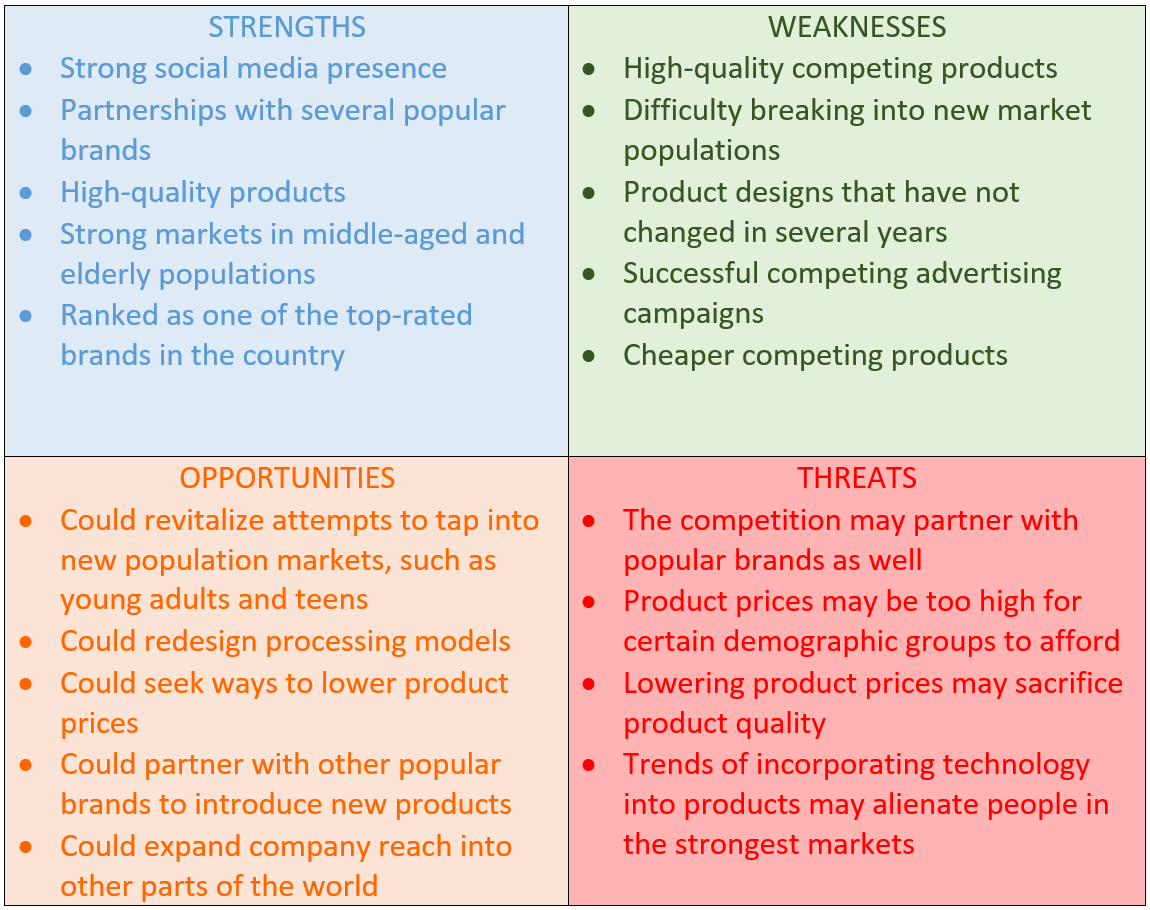
Final Words
The humble but effective SWOT analysis will produce a detailed map of your current environment—its hills and valleys alike. Knowing how to write a SWOT analysis will provide you with the vantage point you need to choose a direction and blaze a trail toward your goals. SWOT analyses may not be crystal balls, but they are something like compasses. Use them wisely, and you will never be lost.
Image source: cookelma/unspla sh.com
Make a Strong Start. Connect with a Professional Editor.
Hire one of our expert editors , or get a free sample, about the author.

Scribendi's in-house editors work with writers from all over the globe to perfect their writing. They know that no piece of writing is complete without a professional edit, and they love to see a good piece of writing turn into a great one after the editing process. Scribendi's in-house editors are unrivaled in both experience and education, having collectively edited millions of words and obtained nearly 20 degrees collectively. They love consuming caffeinated beverages, reading books of various genres, and relaxing in quiet, dimly lit spaces.
Have You Read?
"The Complete Beginner's Guide to Academic Writing"
Related Posts

How to Write a Business Plan

How to Write a Letter of Recommendation

Traditional Publishing versus Self-Publishing: What's the Difference?
Upload your file(s) so we can calculate your word count, or enter your word count manually.
We will also recommend a service based on the file(s) you upload.
English is not my first language. I need English editing and proofreading so that I sound like a native speaker.
I need to have my journal article, dissertation, or term paper edited and proofread, or I need help with an admissions essay or proposal.
I have a novel, manuscript, play, or ebook. I need editing, copy editing, proofreading, a critique of my work, or a query package.
I need editing and proofreading for my white papers, reports, manuals, press releases, marketing materials, and other business documents.
I need to have my essay, project, assignment, or term paper edited and proofread.
I want to sound professional and to get hired. I have a resume, letter, email, or personal document that I need to have edited and proofread.
Prices include your personal % discount.
Prices include % sales tax ( ).

Your Full Guide on How to Write a SWOT Analysis

SWOT analysis is one of those tools that you'll come across in any field. For example, it's used to define a product's competitive advantage, create a strategic plan for a business, and gain insights into consumer behavior.
But it's not just businesses that benefit from this technique. Personal SWOT analysis helps people plan their careers in the most optimal way possible, too.
As versatile as it is, SWOT analysis is not at all complicated. That's why its adoption rate is through the roof. And that's why you should learn how to take advantage of it, whether for an assignment or not.
To help you out with that, let's rely on our rich writing services experience and use it to break down in detail:
- What a SWOT analysis is;
- How it's applied in business strategies and marketing efforts;
- How to use the SWOT framework for any task;
- 4 real-world SWOT analysis examples.
What Is SWOT Analysis, Exactly?
Any SWOT analysis template contains four sections, presented in a two-by-two matrix:

- Strengths – your inherent qualities, resources, or skills that set you apart from the rest;
- Weaknesses – whatever is or may be stopping you or the business from performing well;
- Opportunities – external factors that you can use to your advantage to become more competitive;
- Threats – external factors that may harm your performance in the short or long run.
Internal and External Factors in SWOT Analysis
Each section represents a list of factors. These sections can be grouped into two broader categories: internal and external factors.
Internal factors – Strengths and Weaknesses in the first row – are inherent to you or the company. However, you can also do something about them if need be. Think of your skills as a professional if you're working on a personal SWOT analysis, for example.
External factors – Opportunities and Threats in the second row – aren't under your personal or the company's control. But they have an impact on you or the business, nonetheless. Once-in-a-lifetime pandemics, inflation, or industry trends are good examples here.
Positive vs Negative Factors
Another way to think about the SWOT matrix is by juxtaposing negative and positive factors :
- Strengths and Opportunities can help you or the company achieve your goal or succeed at a project. So, they represent positive factors.
- Weaknesses and Threats can negatively impact your progress and have to be mitigated. They're negative factors.
Why is SWOT Analysis Important?
Now that the question ‘What is a SWOT Analysis?’ is answered, you must have several others on your mind. So let's answer them one by one.
Who Should Do a SWOT Analysis?
Businesses of all sizes and in all industries can benefit from SWOT analyses. So, whether you're a prospective entrepreneur, a small business owner, or a C-level executive, this technique will be a useful arrow in your quiver.
You can also benefit from conducting a personal SWOT analysis. It would be best if you did it when looking for a job or facing a major life decision.
Why Should You Do a SWOT Analysis?
At its core, SWOT analysis is a strategic planning technique. It's meant to help you organize all the factors. That, in turn, enables you to gain key insights into where you stand and how you can move from point A to point B.
How does it help you in strategic planning, exactly? The SWOT matrix shows you:
- Which strengths you should maximize and emphasize;
- Which weaknesses you should minimize and keep at bay;
- Which opportunities you can take advantage of;
- Which threats you should look out for and counter.
All of this leads to one outcome: better, more informed decision-making. Plus, SWOT analysis is notorious for challenging your assumptions as long as everyone involved is straightforward and honest in their answers.
What Can SWOT Framework Be Used For?
Now, let's talk about real-life practical applications of this technique. Here are three SWOT analysis examples:
- Choosing the business model for a new enterprise;
- Creating a break-even analysis and a business plan;
- Analyzing the company's quarterly and annual performance.
At a personal level, you can also conduct your own SWOT analysis to:
- Increase your chances of landing a job;
- Position yourself for getting a promotion;
- Understand what needs to change in your life in general.
Stay on Top of Your SWOT Analysis Homework!
Turn to our professional writers for your upcoming assignment.
How to Conduct a SWOT Analysis in 8 Steps
SWOT analysis isn't complicated to conduct, and that's why they are so popular. Yet, it might be a wrong first impression.
A good SWOT analysis can take hours and should involve multiple people in a brainstorming session. It should also be as objective as possible – which can be harder to achieve than it seems.

So, how do you use a SWOT analysis – and get a quality result for your strategic decision-making process? Here's your step-by-step SWOT analysis example that you can use as a guide. If you need a custom writing -address to professionals.
1. Determine Your Goal
Starting brainstorming without a goal means getting into the SWOT analysis blind. And your SWOT matrix will be useless – or misleading – in the long run.
For example, depending on your goal, the same factor can be a key strength or an irrelevant note. For example, if you aim to reach the 18-25 demographic in your marketing campaign, your active presence on TikTok will be a great asset. But if you need to find a way to attract more quality candidates in the hiring process, the TikTok presence will only help you a little.
So, zero in on what you want to achieve with this SWOT analysis. This can be a decision you or the company have to make – for example, whether to launch a certain product line. Your goal can also be to solve a certain problem or to create/reassess your strategy.
2. Do Your Research
Your research wouldn't be complete if you googled ‘What is a SWOT analysis?’ You'll need a lot of data during your brainstorming session. If you have it, you'll avoid guessing your company's or your own strengths or external threats related to your goal.
What Data to Look For
Your research should consist of two parts:
- Internal research . You'll need every piece of information on your or the company's performance to pinpoint the internal factors in SWOT analysis. That can include financial, sales, marketing, and other reports with key metrics.
- External research . Gather the data on your competitors, the market, the company's position and market share, and the industry as a whole. This data will be the basis for assessing your opportunities and threats.
There's one footnote, though. Depending on the goal, you'll need different data sets. So, focus on relevant data.
3. Pinpoint Your or Your Organization's Strengths
Now, it's time for the brainstorming session. If you're doing a SWOT analysis for a business, go with it: bring the right people to the table, virtual or not. It'll help you get a more objective, realistic, and complete matrix.
Start with the internal factors, namely your internal strengths: they're always easier to home in on.
Need a SWOT analysis example of a company's strengths? Here are five of them:
- Outstanding customer service with a high satisfaction rate;
- Strong financial performance;
- The first-mover advantage;
- Positive brand attributes;
- Strong technical expertise in the field.
5 Questions to Ask
Here are five questions to kick off your brainstorming and help you discover your company's strengths – or your own:
- What do you or the company do well?
- What are your strongest assets?
- Is there something only you or the company do?
- What is your competitive edge?
- What do customers appreciate about the company?
4. Zero in on Your or Your Company's Weaknesses
Now, it's time to move on to a more difficult part of assessing your internal factors: your weaknesses. Take a hard look at your or the business's performance and define what could be going better. Don't try to embellish the truth here!
Keep in mind: there are some weaknesses that you can eliminate and some others that you can only mitigate.
Looking for weaknesses SWOT analysis examples for students who run their businesses? Here are five of them:
- Poor brand recognition among the target audience;
- Suboptimal employee productivity;
- Limited resources, human or otherwise;
- Lack of intellectual property for key technologies;
- Long delivery times.
To explore your personal or business weaknesses, ask the following five questions:
- What do your competitors beat you at?
- What do customers complain about?
- What is holding back your or the company's success?
- What resources do you or the company lack?
- What are the gaps in your internal business processes?
5. Identify External Opportunities
Before you can exploit opportunities, you need to identify them in your SWOT analysis – and determine which ones are worth using, too.
For that, you'll need to turn to the external environment research you've done. Then, look at that data and pinpoint which trends or events you could take advantage of.
Need a SWOT analysis example or two here? Take a look at these three business opportunities:
- New markets emerging within the industry;
- New advertising channels rising to prominence;
- Particular customer needs that remain underserved.
4 Questions to Ask
If you don't know how to start zeroing in on opportunities, start with these four questions:
- Are there ways to gain useful resources you don't have or have little of?
- Are there any technological advancements that can help you mitigate your weaknesses?
- Are there any new or overlooked opportunities that you can exploit?
- How can the current economy or market trends be of use to you?
6. Home in on Potential Threats
Time to move on to the final part of a standard SWOT analysis: threats. These external trends and events can get in your way – or already are.
If you're working on a personal SWOT analysis, threats can include:
- High competition for the job you're after;
- Potential layoffs due to a financial crisis.
If you're conducting one for a large company or a small business, negative external factors can include:
- New emerging competitors, direct or indirect;
- New regulations that can entail considerable additional costs for the business;
- Unfavorable investment climate.
3 Questions to Ask
If you need a push in the right direction, here are three questions to help you zero in on the threats:
- Who are your competitors, and what is their market position?
- What is the state of the economy, industry, and market? Are they in decline?
- Are there any new regulations that can harm the business?
7. Review Your SWOT Analysis Matrix
Having a good SWOT analysis right after brainstorming is impossible. You need to review every factor you've written down and edit the list. Leave only the elements that truly matter – and make them more specific if required.
3 Things to Pay Attention to
There are some common caveats that you can overlook if you need to be more careful during this step. Here are three of them to avoid:
- Factors that aren't specific enough – clarify or cross them out;
- Factors that aren't evidence-based – find proof or get rid of them;
- Factors that are over- or underestimated – have a fresh pair of eyes to look at the list.
8. Decide on the Solution
Once you've finished filling out and editing your SWOT analysis template, your work is only beginning. Now, you need to take your SWOT matrix and use your findings to find the solution to your key issue.
4 Questions to Pose
Here are four questions to guide you in your solution-seeking:
- How can you maximize your strengths? Which ones should be the top priority to boost?
- How can you mitigate or eliminate your weaknesses? Which ones should be taken care of first?
- Which opportunities should you take advantage of? Which ones will pay off the most?
- Which threats can do the most harm? How can you limit their impact?
4 SWOT Analysis Examples for Students
Need something more than just a SWOT analysis template? Let's see how this tool can be applied to practice with these four real-world SWOT analysis examples for students.
But if these sample SWOT analysis still don't help you, don't panic just yet. You can always order an essay online and let professionals worry about it. And no, it won't cost you a small fortune!
Amazon and Tesla Analysis
Apple and personal swot analysis, are you drowning in schoolwork.
Students that need a little additional encouragement with their tasks can benefit from our top essay writing service
Related Articles
.webp)
🦅 Hawker.Blog
5 swot analysis examples for students, introduction.
As a student, it is crucial to have a comprehensive understanding of your strengths, weaknesses, opportunities, and threats. This understanding is not just for academic purposes, but it also plays a significant role in personal and professional development. This is where SWOT analysis comes in. SWOT analysis is a strategic planning tool that helps individuals and organizations identify the internal and external factors that can impact their goals and objectives. It provides a clear picture of where you stand and what you need to work on to achieve your goals. In this article, we will discuss 5 SWOT analysis examples specifically tailored for students. These examples will cover various aspects such as personal development, career planning, academic performance, and business planning.
Understanding your SWOT is not just about listing down your strengths, weaknesses, opportunities, and threats. It’s about analyzing these factors and understanding how they interact with each other. It’s about leveraging your strengths and opportunities, improving your weaknesses, and mitigating your threats. This understanding can help you make informed decisions, set realistic goals, and develop strategies to achieve these goals.
What is SWOT Analysis?
Before we dive into the examples, let’s first understand what SWOT analysis is. SWOT stands for Strengths, Weaknesses, Opportunities, and Threats. It is a simple yet effective tool that helps individuals and organizations assess their current situation and make informed decisions. SWOT analysis can be used for personal development, career planning, and even business planning. It provides a structured way to identify and analyze the internal and external factors that can impact your goals and objectives.
SWOT analysis is not just a tool for businesses. It can be equally effective for individuals, especially students. As a student, you can use SWOT analysis to understand your academic strengths and weaknesses, identify opportunities for growth and development, and recognize potential threats to your academic and career goals. It can help you make informed decisions about your studies, career choices, and personal development.
Strengths refer to the positive attributes or characteristics that give you an advantage over others. These can be your skills, knowledge, experience, or personal qualities. As a student, your strengths can include good time management skills, strong communication skills, or a high GPA. Identifying your strengths is important as it can help you leverage them to achieve your goals. It can also boost your confidence and motivate you to work harder.
In addition to your academic strengths, it’s also important to identify your personal strengths. These can include your personality traits, values, and attitudes that can contribute to your success. For example, being resilient, adaptable, and self-motivated are valuable strengths that can help you overcome challenges and achieve your goals. Understanding your strengths can also help you choose the right career path and make the most of your opportunities.
Weaknesses are the areas where you may lack skills, knowledge, or experience. These can hinder your progress and prevent you from reaching your full potential. As a student, your weaknesses can include poor time management, lack of organization, or difficulty in public speaking. It is important to identify your weaknesses so that you can work on improving them. Recognizing your weaknesses is not about being negative or self-critical, but about being self-aware and proactive.
Working on your weaknesses can not only improve your performance but also enhance your personal growth. For example, if you struggle with public speaking, you can join a public speaking club or take a course to improve your skills. If you have poor time management skills, you can use tools and techniques to manage your time more effectively. By addressing your weaknesses, you can turn them into strengths and increase your chances of success.
Opportunities
Opportunities are external factors that can help you achieve your goals. These can be new trends, advancements in technology, or networking opportunities. As a student, opportunities can include internships, scholarships, or networking events. Identifying opportunities can help you take advantage of them and further your personal and professional growth. It can also open up new possibilities and pathways for your career.
In addition to these, opportunities can also come from changes in the external environment. For example, the increasing demand for digital skills, the growth of remote work, and the rise of entrepreneurship are all opportunities that you can leverage. By staying informed about the latest trends and developments, you can identify and seize these opportunities. Remember, opportunities are not just about what’s available, but also about how you can create and make the most of them.
Threats are external factors that can hinder your progress or pose a risk to your goals. These can include competition, economic changes, or personal challenges. As a student, threats can include financial constraints, lack of job opportunities, or personal issues. Identifying threats can help you prepare for them and minimize their impact on your goals. It can also help you develop strategies to mitigate these threats and protect your interests.
Threats can be unpredictable and beyond your control. However, by being aware of potential threats, you can be better prepared to deal with them. For example, if you are aware of the high competition for job opportunities in your field, you can work on improving your skills and gaining relevant experience to stand out from the competition. If you are facing financial constraints, you can explore scholarships, part-time jobs, or financial aid options. By proactively managing threats, you can reduce their impact and ensure your progress towards your goals.
SWOT Analysis Examples for Students
Now that we have a clear understanding of what SWOT analysis is, let’s look at 5 SWOT analysis examples for students. These examples will cover different aspects such as personal development, career planning, academic performance, and business planning. They will provide a practical guide on how to conduct a SWOT analysis and how to use it to make informed decisions and develop effective strategies.
Example 1: Personal SWOT Analysis

This example is specifically tailored for students who want to assess their personal strengths, weaknesses, opportunities, and threats. It can be used for personal development, career planning, or even for academic purposes. A personal SWOT analysis can help you understand yourself better, identify areas for improvement, and develop strategies to achieve your personal and professional goals.
- Good time management skills
- Strong communication skills
- Ability to work well in a team
- Creative thinking
These strengths can give you a competitive edge in your studies, career, and personal life. They can enhance your performance, increase your productivity, and improve your relationships. By leveraging these strengths, you can achieve your goals more effectively and efficiently.
- Procrastination
- Difficulty in public speaking
- Lack of organization
- Poor study habits
- Inability to handle stress
These weaknesses can hinder your progress and affect your performance. However, by recognizing and addressing these weaknesses, you can turn them into strengths. You can use strategies, tools, and resources to improve these areas and enhance your skills and abilities.
- Internship opportunities
- Networking events
- Study abroad programs
- Leadership roles in student organizations
- Career fairs
These opportunities can provide valuable experiences, knowledge, and connections that can boost your career and personal growth. By seizing these opportunities, you can enhance your skills, expand your network, and increase your chances of success.
- Financial constraints
- Competition for job opportunities
- Personal issues
- Changing job market
- Academic pressure
These threats can pose challenges and risks to your goals. However, by identifying and managing these threats, you can minimize their impact and protect your interests. You can develop strategies to mitigate these threats and ensure your progress towards your goals.
Example 2: Career SWOT Analysis

This example is specifically tailored for students who are about to enter the job market or are looking to switch careers. It can help you assess your strengths, weaknesses, opportunities, and threats in relation to your career goals. A career SWOT analysis can provide valuable insights into your career prospects, potential challenges, and strategies for success.
- Relevant education and skills
- Internship or work experience
- Strong references
- Good networking skills
- Positive attitude
These strengths can enhance your employability and increase your chances of landing a job. They can also help you perform well in your job and advance in your career. By leveraging these strengths, you can stand out from the competition and achieve your career goals.
- Lack of experience in a specific field
- Limited knowledge of industry trends
- Inadequate technical skills
- Poor time management
- Difficulty in adapting to change
These weaknesses can affect your job prospects and career growth. However, by recognizing and addressing these weaknesses, you can improve your skills and increase your employability. You can take courses, attend workshops, or seek mentorship to enhance your knowledge and skills.
- Job openings in your field of interest
- Professional development courses
- Industry conferences
- Mentorship programs
These opportunities can provide valuable experiences, knowledge, and connections that can boost your career. By seizing these opportunities, you can enhance your skills, expand your network, and increase your chances of landing a job or advancing in your career.
- High competition for job opportunities
- Economic changes
- Rapidly changing job market
- Personal challenges
- Limited job growth in your field
These threats can pose challenges and risks to your career goals. However, by identifying and managing these threats, you can minimize their impact and protect your career interests. You can develop strategies to mitigate these threats and ensure your progress towards your career goals.
Example 3: Academic SWOT Analysis
This example is specifically tailored for students who want to assess their academic strengths, weaknesses, opportunities, and threats. It can help you identify areas where you excel and areas where you need to improve. An academic SWOT analysis can provide valuable insights into your academic performance, potential challenges, and strategies for success.

- Good study habits
- Strong understanding of core subjects
- Ability to work well under pressure
These strengths can enhance your academic performance and increase your chances of success. They can also help you excel in your studies and achieve your academic goals. By leveraging these strengths, you can maximize your academic potential and achieve excellence.
- Difficulty in understanding certain subjects
- Inadequate note-taking skills
- Lack of participation in class
These weaknesses can affect your academic performance and hinder your progress. However, by recognizing and addressing these weaknesses, you can improve your skills and enhance your academic performance. You can use strategies, tools, and resources to improve these areas and enhance your academic skills.
Photo by Javier Trueba
Read more on the topic


25,000+ students realised their study abroad dream with us. Take the first step today
Here’s your new year gift, one app for all your, study abroad needs, start your journey, track your progress, grow with the community and so much more.

Verification Code
An OTP has been sent to your registered mobile no. Please verify

Thanks for your comment !
Our team will review it before it's shown to our readers.

- Leverage Beyond /
SWOT Analysis for Students
- Updated on
- May 11, 2023

Wondering what to do when you are stuck at a limbo point in your career? Well, SWOT analysis can be extremely helpful in exploring your strengths and weaknesses and how they are playing an incremental part in your career . As a student, you might be confused about your future plans regarding the course and university that can give wings to your ambitions. Don’t worry, it is quite normal. Before you go any further and mess it all up, you need to do a SWOT analysis of yourself. This blog details the key elements of how to carry out a SWOT analysis for students and how this strategic evaluation can help every individual in extracting their maximum potential.
This Blog Includes:
What is swot analysis, swot analysis ppt, why swot analysis is important, how to write swot analysis for students, strengths examples for students, weaknesses examples for students, opportunities examples for students, threats examples for students, use of swot analysis for students.
Sign up here for a FREE Career Counselling Session!
Well, you might have heard about people performing a SWOT analysis before they start a business venture or hire new employees. It is equally crucial for students as well. It’s an amazing way to comprehend your strengths and shortcomings. SWOT is an acronym for ‘Strengths’ ‘Weaknesses’ ‘Opportunities’ and ‘Threats’. It’s an evaluative strategy where you pick out your weaknesses to overcome and enhance your plus points. These four forces can determine your future course of action. Whether it is pursuing a career or going for higher studies, students often find themselves trapped when they lack basic skills. This happens when you are not sure about your potential. That’s where this magic SWOT analysis for students comes to play. Whether it is making an appealing SOP for a foreign university or it is appearing in an interview in person, a SWOT analysis helps in bringing clarity about how your personality traits fit your career aspirations .
Socrates must have known the potential of the human soul when he said: “ Know thyself .” Knowing yourself is the first step towards making your dreams come true. Using the SWOT analysis, students often find their unexplored talents, hence giving them an edge to explore the right career path for them. It helps you extend your strengths and pinpoint your shortcomings on time. Once done, the doors for opportunities will start opening and you will emerge as a better person. To be able to stand out in a crowd, a student needs to focus on his strengths and weaknesses while looking for opportunities and evading threats. But that’s not easy. To be able to do that correctly, you must settle down for self-introspection.
To help you understand the different aspects of the SWOT analysis, we have listed below the essential elements of this evaluative test:
In the SWOT analysis for students, this element defines the skills and achievements that you have acquired over a period of time. From a professional or academic point of view, you can list and describe the skills and professional knowledge you have acquired. Other strengths regarding your personality like critical thinking, leadership and time management skills can be your plus point while mentioning your strengths. Do not forget to mention how loquacious and flexible you are in terms of handling different situations.
While facing a panel of interviewers, you need not be anxious if you don’t have any positive points left to mention in your SWOT analysis. Don’t be ashamed of talking about your weaknesses. You can start with how you failed to hook your audiences in a seminar at your school. Wondering how that is going to help you? Well, explaining your weaknesses makes you more authentic and trustworthy.
Opportunities
Having acquired a skillset over a period of time, you might end up thinking about what to do with them. Hunting for opportunities rather than waiting for them is a positive characteristic. From thousands of opportunities, choosing the one that is best for you is a skill you need to imbibe.
If you are worried about the threats that you might encounter during your career journey or while seeking admission at a university, then you should know that these challenges will end up making you stronger. Whether it is about limited seats in a university or facing a tough challenge in an interview, difficulties are a part of the process.
Now that we know what a SWOT Analysis is, let’s check how to write SWOT Analysis for students.
When you are doing the SWOT analysis, you do not need to follow the exact same order but you can do it as per your comfort:
- Identify your goals
First, identify the end goal you wish to achieve through your SWOT analysis. You must be aware of what you wish to do. Your goal should be achievable, reliable and within an expected time frame.
- Identify your strength and weakness
Now that you know your goals, list down the strength you have and the weaknesses that may prevent you from achieving it. Write your strengths and weaknesses, take support from your friends and family if you need.
- Identify opportunities and threats
Once you have noted your strengths and weaknesses, list down the opportunities you can grasp that can help you achieve your goal. Next, check the threats whether internal or external, that can stand in your way of your opportunities.
Once you have identified the entire SWOT analysis, make changes if required.
SWOT Analysis Examples for Students
While carrying out SWOT Analysis, here are the major questions you need to ask yourself for each section:
- What are your best traits?
- What different advantages do you have? (in terms of educational qualifications, work experience, networks, etc.)
- What strategies do you use to reach your goals?
- What strengths do others see in you?
- What type of resources do you have to invest in your career path?
- What disadvantages do you need to work on?
- In which areas, you need more education or skill-based training?
- What personality traits do you consider to improve on?
- What type of tasks do you avoid due to lack of knowledge or confidence?
- What are your negative traits or habits?
- What type of resources do you lack to advance towards your career?
- How can you use your strengths by turning them into possible opportunities?
- How can you use your weaknesses in learning opportunities to improve yourself?
- What are the emerging trends in your chosen career field and how can you take advantage f those trends?
- How you can use your time efficiently to seek better opportunities?
- What types of obstacles are you facing in your chosen field of interest?
- Are any of your strengths holding you back?
- Are any of your weaknesses preventing you from becoming successful?
- Are there any obligations that are limiting your personal or professional development?
SWOT analysis can help you in many ways. Let’s check them out:
- Understand yourself better
- Work on your weaknesses
- Focus on your strength
- Build your opportunities
- Counteract threats
- Time management
SWOT is an acronym for ‘Strengths’ ‘Weaknesses’ ‘Opportunities’ and ‘Threats’.
SWOT Analysis is an evaluative strategy where you pick out your weaknesses to overcome and enhance your plus points.
Understand yourself better Work on your weaknesses Focus on your strength Build your opportunities Counteract threats Time management
We hope that you gained clarity about the process of SWOT analysis for students. This critical evaluation can help you sort out what you have achieved in life and what you are aspiring for. Leverage Edu experts can further assist you in discovering a suitable course and university that can provide you with the right knowledge and exposure to your chosen field of career. Call us immediately at 1800 57 2000 for a free 30-minute counselling session.
Team Leverage Edu
Leave a Reply Cancel reply
Save my name, email, and website in this browser for the next time I comment.
Contact no. *
I don’t have much knowledge about SWOT as I belonged to a less privileged family. I am the first person who entered a college campus for higher studies. Hope I can utilise each & every opportunity to fulfill my dreams.
Very much helpful! Thanks mate…

Leaving already?
8 Universities with higher ROI than IITs and IIMs
Grab this one-time opportunity to download this ebook
Connect With Us
25,000+ students realised their study abroad dream with us. take the first step today..

Resend OTP in

Need help with?
Study abroad.
UK, Canada, US & More
IELTS, GRE, GMAT & More
Scholarship, Loans & Forex
Country Preference
New Zealand
Which English test are you planning to take?
Which academic test are you planning to take.
Not Sure yet
When are you planning to take the exam?
Already booked my exam slot
Within 2 Months
Want to learn about the test
Which Degree do you wish to pursue?
When do you want to start studying abroad.
September 2024
January 2025
What is your budget to study abroad?

How would you describe this article ?
Please rate this article
We would like to hear more.
- Skip to primary navigation
- Skip to main content
- Skip to primary sidebar
PESTLE Analysis
Insights and resources on business analysis tools
SWOT Analysis Examples For Students of All Ages
Last Updated: Apr 7, 2024 by Abdul Momin Filed Under: SWOT Analysis , SWOT Examples
Do you even know what wonders SWOT analysis can do in your life? Did you know that SWOT analysis has the power to make you self-aware? Probably not.
At this point, you might think that SWOT analysis benefits businesses, not individuals. Well, that’s what most people think. However, that’s not true.
SWOT analysis is a tool that makes individuals and businesses self-aware by highlighting their strengths, weaknesses, opportunities that lie ahead of them, and threats that they face from the external environment.
Applying SWOT analysis helps businesses and individuals in making crucial decisions. Students can also use SWOT analysis at different stages to become more self-aware and explore the opportunities and threats present to them.
Today, we will provide some SWOT Analysis Examples For Students to make them aware of using SWOT analysis to improve their lives.
What is SWOT Analysis?
Before proceeding with the examples, let’s discuss SWOT analysis. SWOT analysis is a tool that highlights the factors that affect the operations of a business, industry, or individual.
The SWOT analysis analyses the strengths, weaknesses, opportunities, and threats present for a business or an individual. Businesses use SWOT analysis to make informed decisions.
For example, the SWOT analysis of Coca-Cola highlights that Coca-Cola has an opportunity to increase its presence in developing economies.
Coca-Cola can use this finding of the SWOT analysis to expand its operations in developing economies since it provides Coca-Cola with a growth opportunity.
Other than businesses, individuals can also use SWOT analysis for personal development . For example, a SWOT analysis will highlight the strengths, weaknesses, opportunities, and threats present for an individual.
The SWOT matrix of an individual can help him/her to overcome the weaknesses highlighted in the SWOT analysis and avail the opportunities that are present.
Conducting a personal SWOT analysis can help college students since it can provide them with self-awareness, which will help them in their career and personal life.
A SWOT analysis for college students will highlight the strengths of college students. For example, college students are more energetic and creative compared to 30-year-old individuals.
College students can use these strengths to be more productive and achieve more. Furthermore, the college students’ SWOT analysis will highlight the weaknesses of the college students as well.
Once the SWOT analysis highlights the weaknesses, college students can overcome these weaknesses so that they can excel in their careers and lives.
Moreover, college students can avail the opportunities highlighted by the SWOT analysis and take steps to mitigate the threats.
Other than college students, students in general can use SWOT analysis to identify their strengths, weaknesses, opportunities, and threats from the external environment.
Let’s proceed further and discuss how students and different levels can use SWOT analysis for their benefit.
SWOT Analysis Example for School Students
Students at every level should be self-aware. School students can use SWOT analysis to analyze their strengths, weaknesses, opportunities present for them, and threats that they face. Let’s proceed further and conduct a SWOT analysis for a school student.
Strengths Examples for School Students
Strengths refer to the factors that would provide a competitive edge to the school students over their peers. Let’s discuss the strengths of a school student.
- Skills And Talents: A specific skill or talent could be the strength of a school student. For example, if a student is good at painting and arts, this would distinguish him/her from other students, and this talent can be considered the student’s strength.
- Good Interpersonal Skills: A student’s ability to communicate well with peers and teachers can be a strength. Good communication skills will help the student in their personal and professional lives.
- Time Management Skills: A student with good time management skills will have an advantage over others. Suppose a student can manage studies and extracurricular activities together well. In that case, his/her prospects of success in professional life increase.
Weaknesses Examples for School Students
Weaknesses are the shortcomings of a student that act as a barrier to a student’s growth. Every student possesses some weaknesses, but a successful student is the one who identifies his/her weaknesses and overcomes them. Let’s discuss some of the weaknesses that school students possess.
- Poor Study Habits: Poor study habits can act as a weakness for a school student. If a student procrastinates a lot and isn’t focused while studying, then he/she has poor study habits, which could act as a weakness.
- Poor Communication Skills: Poor communication skills are considered a weakness of a school student. A student with good communication skills can communicate with their teachers and peers.
- Poor Behavior: No matter how good a student is academically, if he has poor behavior, it will be difficult for him to excel professionally and personally.
Opportunities Examples for School Students
The opportunities section will highlight the chances for a school student to grow. Let’s analyze the opportunities present for a school student.
- Improve Academically: A student always has the opportunity to improve academically in areas he/she lacks. By improving in such areas, students have an opportunity to improve their academic performance.
- Improve Communication: A school student who lacks in communication has the opportunity to improve his communication skills. Improving communication skills will benefit the student in professional and personal life.
- Perform More Extracurricular Activities: Extracurricular activities help students to develop interpersonal and intrapersonal skills. A student has an opportunity to perform more extracurricular activities.
Threats Exampes for School Students
Threats refer to the external factors that affect the performance of a student. Let’s analyze what the threats present for a school student are.
- Health Issues: School students should pay attention to their health; otherwise, they might face health issues that can impact their performance significantly.
- Peer Pressure: Peer pressure is a dangerous thing. It can force young school students to get involved in activities that can have a severe negative impact on their personal and academic life.
- Academic Challenges: A school student might find courses or exams challenging. These academic challenges can affect a student’s academic performance.
SWOT Analysis Example for College Students
A college student is more mature than a school student and faces different hardships. A college student’s strengths, weaknesses, opportunities, and threats differ from a school student’s.
Let’s conduct a SWOT analysis of a college student to see what internal and external factors impact his performance.
Strengths Examples for College Students
This section will highlight some of the strengths of a college student.
- Academic Achievements: Academic achievements are considered the strengths of a college student. A college student with maximum academic achievements would have a competitive advantage over his peers.
- Analytical Skills And Critical Thinking Skills: A student with strong analytical and critical thinking skills will make well-informed decisions and thoroughly grasp the knowledge gained academically. Hence, he will have an advantage over his fellow students.
- Networking Abilities: Networking with the right people is very important for a college student since it helps the student get career-related guidance.
Weaknesses Examples for College Students
This section of the SWOT analysis will analyze the weaknesses present in a college student.
- Financial Constraints: A college student might face financial constraints since attending college requires a lot of money. Financial problems would impact the college and personal life of a student negatively.
- Poor Mental Health: College students often deal with mental illness. Poor mental health can have a damaging impact on the life of a college student.
- Career Uncertainty: College students usually need clarity regarding what career they will choose. Due to this, they are unable to set academic goals.
Opportunities Examples for College Students
Opportunities are the chances that college students get to excel in life. Let’s analyze some of the opportunities that college students get.
- Internship Opportunities: College students can work in organizations as internees to gain some experience and develop an understanding of the corporate culture. Internship opportunities help college students in making career-related decisions .
- Study Abroad Programs: Study abroad programs provide the opportunity for college students to study abroad. Availing such opportunities can help college students gain more exposure.
- Leadership Opportunities: A college student can develop leadership skills by joining student organizations and clubs.
Threats Examples for College Students
College students also feel threatened by various external factors. Some of them are discussed in this section.
- Academic Challenges: A college student may find the course hard and find it hard to pass the exams. Academic challenges can act as a threat to college students.
- Unemployment In The Job Market: College students do odd jobs to support themselves. However, unemployment in the market can make it difficult for college students to find jobs and support themselves.
- Mental Breakdown: College students go through a lot emotionally, whether because of personal relationships or professional life. A college student may have a mental breakdown due to the stress and pressure.
SWOT Analysis Example for University Students
University students must also analyze their weaknesses, strengths, opportunities, and threats they face to gain more awareness about themselves. SWOT analysis helps university students to highlight the internal and external factors that affect them.
Let’s take a look at the strengths that university students face.
Strengths Examples for University Students
This section will highlight some factors that will act as strengths for university students.
- Adaptability: Some university students can quickly adapt to new situations and scenarios. This ability of adaptation acts as a strength for university students.
- Digital Literacy: Digital literacy is utilizing technology and digital tools for research, university tasks, and communication. Any university student who has digital literacy will excel.
- Critical Thinking: If a university student can think critically, he can gain a competitive advantage over his peers.
Weaknesses Examples for University Students
Weaknesses are the shortcomings that prevent university students from achieving their true potential. Let’s analyze some weaknesses of university students.
- Poor At Public Speaking: Many university students have theoretical knowledge but are not good at public speaking. Due to this, they tend to miss out on many opportunities.
- Lacking Technical Skills: Universities need to teach technical skills since they help individuals get good jobs. However, some university students lack technical skills.
- Poor Balance Between Academic And Social Life: A lot of university students find it challenging to maintain a balance between their academic and social lives. As a result, their productivity is affected.
Opportunities Examples for University Students
Opportunities section highlights the chances available for university students to grow. Let’s look at the opportunities for growth presented to university students.
- Internship Opportunities: University students have the opportunity to do internships so that they become aware of the job market and the corporate culture.
- Professional Development Courses: University students can enroll in different courses and learn different skills. These skills can increase their skills and help them get better jobs after graduation.
- Networking: Networking helps university students in getting jobs. University students can network with teachers who can help them in getting jobs.
Threats Examples for University Students
University students also face threats from the external environment. Let’s take a look at the threats that university students face.
- Financial Constraints: Affording the university fee is very difficult for university students. Many students drop out of university since they can’t afford it.
- High Rate of Unemployment: A high unemployment rate in the market can threaten university students since it will lower their chances of getting good jobs after graduating.
- Competitive Job Market: High competition in the job market will make it difficult for new graduates to find a good job . Hence, high competition in the job market threatens university students.
SWOT Analysis Examples For Students: Final Word
SWOT analysis is a tool businesses and individuals use to find out what internal and external factors impact them.
SWOT analysis analyzes the strengths, weaknesses, opportunities, and threats businesses and individuals face.
Students use SWOT analysis to get self-awareness. The SWOT analysis results help students realize their strengths and weaknesses. Moreover, SWOT analysis also highlights the opportunities and threats present for students.
In today’s article, we conducted a SWOT analysis for students at different levels. First, we conducted a school student SWOT analysis, then a college student SWOT analysis, and finally, a university student SWOT analysis giving examples for each one.
Each SWOT analysis highlighted the external and internal factors that affect students at different levels.
Start Teaching
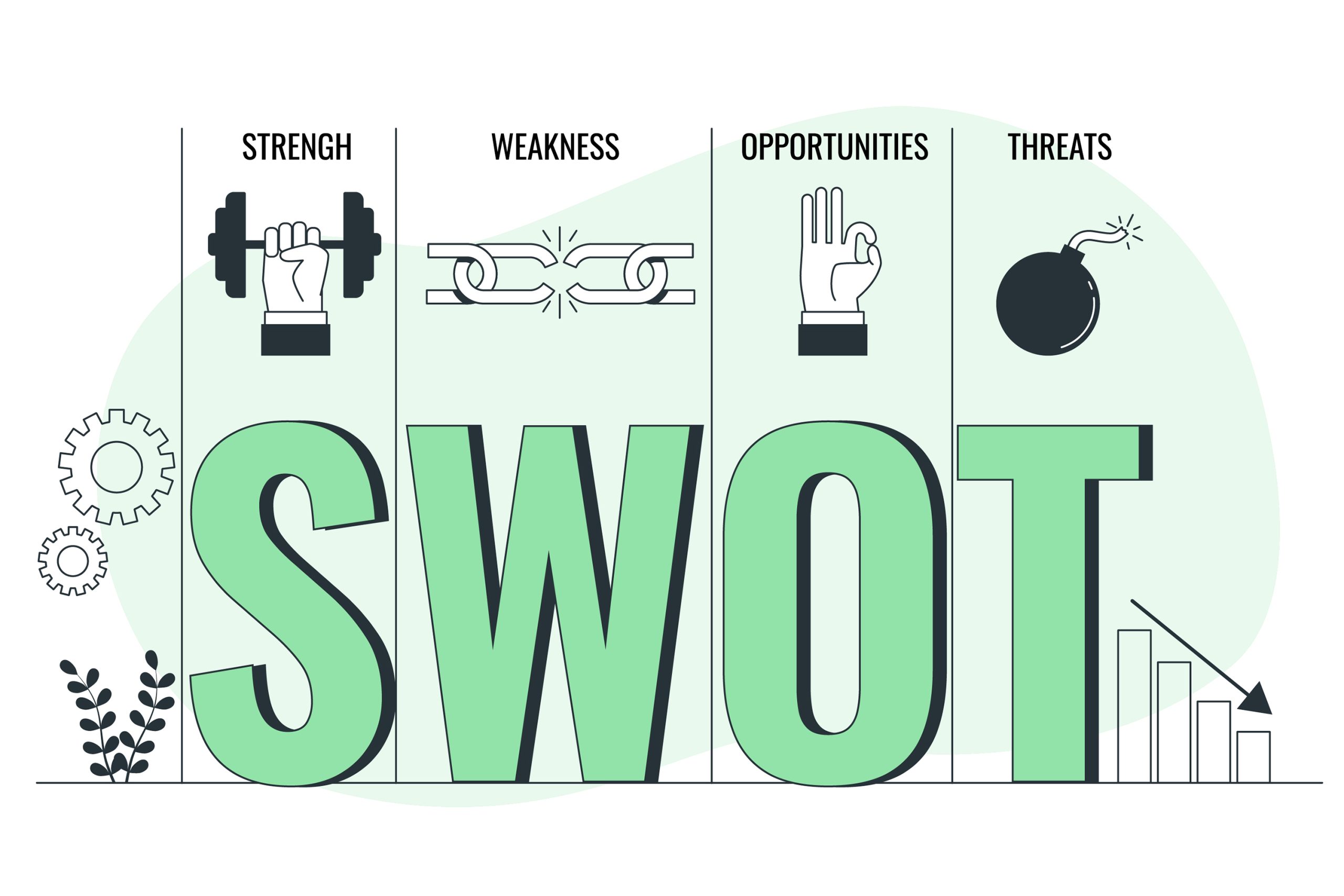
What Is A Personal SWOT Analysis For Students?
Last Updated on 29/08/2023 by James Barron
Table of Contents
This article delves into the significance and application of SWOT analysis, a crucial tool for business, marketing, teaching and individual self-assessment. Originated in the 1960’s by Albert Humphrey, SWOT, originally known as the SOFT analysis, evaluates strengths, weaknesses, opportunities, and threats of an entity, be it an organisation or an individual. While businesses employ SWOT to identify internal capabilities and external challenges, individuals, particularly students, can harness it to gain insight into their attributes and chart out their academic or career trajectories. This article delineates the steps to conduct a personal SWOT analysis, underscoring the importance of introspection and external feedback. Whether one is a student, entrepreneur, or professional, integrating SWOT analysis into decision-making processes can provide a holistic view of one’s position and potential, steering them towards more informed and advantageous choices.
Introduction
Individuals attempting to break into the many different industries, including business, marketing, teaching, etc., will need to learn many terms, techniques, and strategies. One of the most important is the SWOT analysis, which is a vital business, marketing and teaching theory. The technique can be very beneficial when developing a plan because it helps analyse the internal weaknesses and strengths of the subjects, but also the external opportunities and threats .
It will also identify external factors and opportunities. Students can also benefit from using SWOT analysis since it provides insight into their best and worst attributes. More about SWOT analysis for students can be found below.
First, students should learn more about SWOT, which is also called the SWOT method and the SWOT matrix. In the business world, SWOT is a technique designed to study a company’s internal factors, such as its weaknesses and strengths. It will also help pinpoint external factors, including potential threats and viable opportunities.
Using the framework is an excellent way to find unique opportunities for the business and make the most effective business decisions. Students can also use SWOT to make better decisions.
SWOT History
The SWOT technique has been used for many years since it was developed sometime in the 1960’s by Albert Humphrey and his team. At the time, Albert was working for the Stanford Research Institute. Humphrey and his associates created a framework to enable businesses to create more sustained strategies.
Initially, the SWOT technique was known as the SOFT analysis, standing for satisfactory, opportunity, fault, and threat. Although the name has changed, the SWOT model remains an effective way to identify any company’s external and internal factors. Eventually, Humphrey and his teammates introduced an even more effective technique to help identify specific aspects.
For instance, the new technique can be used to learn more about products, distributions, customers, finances, and more.
What Does SWOT Stand For?
SWOT has become a staple of the marketing industry because it can empower businesses to reach new customers and identify viable opportunities. It stands for strengths, weaknesses, opportunities and threats. In other words, the analysis technique can help identify factors in each category.
Internal factors, such as weaknesses and strengths, can usually be controlled by the company in question. It can change business practices to offset these weaknesses and strengthen its weakest components. As for external factors and threats, the company will not be able to change these things. Instead, it should identify these things before creating plans to shield the business from such threats.
S For Strengths – When a company looks at its strengths, it is identifying the things it does best. These things can help the company determine what makes it better than rival companies.
W For Weaknesses – Even the best company has weaknesses or things that prevent it from reaching its maximum efficiency. Weaknesses should be identified and rectified.
O For Opportunities – Every company has opportunities. Before a company can take advantage of these opportunities, they have to be identified. The SWOT analysis technique can help.
T For Threats – Businesses can use SWOT to discover potential threats that could harm the company.
As previously mentioned, SWOT analysis has been used since the 1960’s. Although it was primarily created to help with business planning, it can also be used for other purposes. For instance, someone can use the SWOT method to analyse a specific person or industry.
Understanding Personal SWOT Analysis
Businesses can benefit greatly from using the SWOT method, but individuals should not ignore its benefits. Performing a personal SWOT analysis is a good way to study a person’s opportunities, strengths, and weaknesses. The SWOT method can be used to study any person, regardless of age or career. Furthermore, it can help people find the best educational courses, career paths, and more.
Importance Of Personal SWOT Analysis
Businesses fully understand the importance of the SWOT method. As for individuals, many overlook this technique. Unfortunately, this means that they’re going to miss out on potential opportunities. When someone is preparing for immense changes, they should study their options and the potential outcomes. Otherwise, they may choose the wrong path and run into serious problems. SWOT analysis is great in this situation because it helps find the best possible route.
Relying on the technique may help the participant avoid costly mistakes, since it will identify their best attributes, weaknesses, external threats, and viable opportunities. When working through the process, you will need to jot down your strengths so you can see which advantages you have over your competitors. Learning more about your strengths will make it easier to achieve your goals.
However, it is also important to learn more about your weaknesses since they could prevent you from reaching your full potential. Once a person has discovered their weaknesses, they may be able to improve themselves in these areas. Alternatively, they can leverage their strengths to downplay their weaknesses. Finding opportunities is essential since these opportunities may empower a person to achieve their goals.
Finally, the participant should study their outside threats. It could be a competitor or room for mistakes. Once these threats are known, the person can begin taking steps to shield themselves from these issues. Truthfully, SWOT analysis can be an integral part of the decision-making process. The comprehensive self-assessment will help ensure that the participant makes the best decision to propel themselves toward their goals.
Four Quadrants
Participants will find that the analysis consists of 4 quadrants. There are internal and external factors. In terms of internal factors, the participant has to worry about their strengths and weaknesses. These things can be changed to make it easier to achieve their goals. Unfortunately, external factors cannot be changed since you cannot control your competitors.
The important external factors include threats and opportunities. To effectively identify these things, a number of questions must be answered.
Personal SWOT Analysis Steps
It isn’t difficult to perform a personal SWOT analysis, but you must know the basic steps. Once you’ve learned the steps, you can use them to study yourself, your business, your industry, and more. Start by following the steps below to complete your personal SWOT analysis.
Start By Asking Questions About Yourself
Since you’re performing a personal SWOT analysis, you need to learn more about yourself. You need to make sure that you’re getting the right answers so you’ll have a much better understanding of your strengths and weaknesses. When you’re studying your strengths, you need to know about unique skills that no one else has. You’ll also want to know what you enjoy doing. It is also wise to find out what others think your strengths are. More about this will be provided below.
Identify Strengths
First, you should identify your most important strengths. Find out what you like doing and what you’re good at. Do you have any skills that other people do not? Identify your strengths because you can use this information to find the best career path for you.
Identify Weaknesses
Although some people don’t want to admit it, everyone has weaknesses. There could be things that are preventing you from accomplishing things. Write these things down. You also need to find out which attributes and skills need to be improved. Finally, be sure to pinpoint your bad habits.

Find Opportunities
You have to discover your best opportunities. Most people can find opportunities by using their personal network, since family, friends, and colleagues will be only too pleased to help. Find out how your skills can make you a good choice for a specific career path. Identify potential changes in your desired industry that you may be able to benefit from later.
Understanding Threats
Finally, you should begin asking questions about potential threats. Is there a chance that aspects of your personality are hurting your career prospects? Are competitors doing a better job than you? Do other applicants have certain skills that you do not? Will your financial situation prevent you from achieving your goal?
Gather The Answers
Once you’ve identified the key questions, you should begin writing down the answers. Don’t be afraid to write down even the smallest points because they can make a big difference. Having a more comprehensive self-assessment will make it more effective as well.
Question Others
You’ll only have so many answers so you’ll have to ask others as well. Your coworkers and bosses can tell you a lot about your strengths, weaknesses, and more. Make sure that these people are being honest. Otherwise, generous answers may provide inaccurate results.
Write Everything Down
Along the way, you should have written everything down. If you haven’t, make sure that you do it now. Once you’ve done this, you should look over your answers to see which ones are not important. These answers can be removed if they’re not going to make a difference.
Finding Solutions
Near the end of the SWOT analysis, you must begin working to find solutions. The self-assessment can help you discover ways to resolve your personal problems and overcome external obstacles. You can use this information to develop a plan to achieve your goals.
SWOT Analysis For Specific Careers
The process will be slightly different, depending on the participant’s desired career path. For instance, someone attempting to obtain a degree in business will have different answers and threats than someone in the customer relations field. Regardless, each applicant can use SWOT to learn more about themselves and their career fields so they can make the best decisions.
Each person just needs to provide the relevant answers and study them to ensure that they’re moving towards their goal.
Example SWOT Analysis: College Student
- Time Management: Proficient in managing academic workloads, part-time job, and extra-curricular activities.
- Tech-Savvy: Highly skilled in using digital platforms and tools for research, presentations, and communication.
- Team Player: Has a track record of collaborating effectively on group projects and in student organisations.
- Adaptability: Able to quickly adjust to various teaching styles and course structures.
Weaknesses:
- Procrastination: Sometimes waits until the last minute to start assignments or study for exams.
- Public Speaking: Experiences anxiety when presenting in front of the class or larger audiences.
- Overcommitment: Tends to take on too many responsibilities, leading to stress and potential burnout.
- Limited Professional Experience: Primarily academic knowledge, with limited real-world experience or internships in chosen field.
Opportunities:
- Internships: Several companies offer internships to students, allowing them to gain practical experience.
- Networking Events: The college regularly hosts seminars and workshops where students can connect with professionals.
- Study Abroad: The possibility to study a semester abroad can offer cultural insights and a global perspective.
- Online Courses: Can supplement college education with specialised online courses to gain more in-depth knowledge or skills.
- Economic Downturn: An economic recession can impact job opportunities after graduation.
- Competition: Many peers with similar or even better qualifications competing for the same positions or opportunities.
- Rapid Technological Change: The risk of current skills becoming obsolete as technology and industries evolve.
- Student Loan Debt: The burden of student loans can limit post-graduation choices and opportunities.
Example SWOT Analysis: Adult Student Teacher
- Life Experience: Brings a rich tapestry of real-world experiences to the classroom that can enhance lessons and student understanding.
- Maturity: Has a higher level of patience and emotional intelligence due to age and experiences, which can be helpful in classroom management.
- Diverse Skill Set: May have skills and knowledge from a previous career that can be integrated into teaching.
- Dedication: The decision to switch to teaching later in life often indicates a strong commitment to the profession and a passion for making a difference.
- Technological Learning Curve: Might face challenges adapting to the latest educational technology and tools.
- Physical Stamina: Longer hours on their feet and the demands of managing a classroom might be challenging.
- Adaptation to Institutional Routines: Navigating the bureaucracy and politics of school systems may be new and challenging.
- Balancing Commitments: Juggling between family, maybe another job, and the demands of student teaching can be daunting.
- Mentorship: Can establish meaningful mentor-mentee relationships with experienced teachers who value the unique perspective of an adult student teacher.
- Community Engagement: Leveraging previous connections from other careers or experiences for classroom activities or projects.
- Professional Development: Access to continuous learning opportunities, both to improve teaching skills and to bridge any technological gaps.
- Alternate Pathways: Some educational systems offer fast-track or alternate certification routes for mature entrants into teaching.
- Age Bias: Potential bias from colleagues or hiring administrators who may favour younger, traditionally-trained teachers.
- Dynamic Curriculum Changes: The curriculum and educational strategies might evolve, requiring continuous adaptation.
- Financial Pressures: If transitioning from a higher-paying job, the initial teacher salary might be a significant adjustment.
- Work-Life Balance: Given the demands of teaching, lesson planning, grading and family, achieving a work-life balance might be more challenging.
Who Should Complete A SWOT Analysis?
Many can benefit from using the SWOT analysis. Whether the participant is a business owner or they’re preparing for a future career, they should complete a quick SWOT analysis to ensure they’re making the right decisions. The technique is universally helpful so it can be used by businesses, students, investors, and more.
Before making any big education or career decision, use the SWOT technique to ensure that you’re not making the wrong decision.
Who Can Benefit From A Personal SWOT Analysis?
Children, teenagers, young adults, and seniors can greatly benefit. Facing the biggest decision of your life, analyse your strengths and weaknesses. It is ideal for professional athletes, educators, entrepreneurs, students, patients, scientists, small business owners, and people considering a political career.
When Is A SWOT Analysis Necessary?
Students of all ages can benefit from a SWOT analysis at any time. There is no set time to take advantage of these studies. In fact, the technique can come in handy in preparation for exams at any time. While more common among college students, school aged students can benefit as well.
The technique can be done on the go or in the comfort of your home.
How Does A Personal SWOT Analysis Work?
The process does not require any special skills, materials, or preparation. A PC or laptop is preferable but not necessary. Students can jot down their weaknesses and strengths on a sheet of paper.
Utilising columns to keep the strengths and weaknesses separated, students will have a better idea of what they need to work on. To maximise the benefit of the technique, incorporate your threats and opportunities into the mix. It is recommended to focus only on the important aspects of your life. Otherwise, the process will just be a waste of time.
What Benefits Are Offered By A Personal SWOT Analysis?
There are way too many benefits to list in this article. It is recommended to have a target (goal) in mind in advance to rule out any risk of confusion.
The primary benefit of the method is for students to identify their weaknesses. It can be incorporated into the decision-making process. For example, students can rely on the technique to decide which career path to take after leaving school.
What is a SWOT analysis?
SWOT analysis is a technique used to study a subject’s internal weaknesses and strengths as well as external opportunities and threats. It is used in various industries including business, marketing, and teaching.
What does SWOT stand for?
SWOT stands for Strengths, Weaknesses, Opportunities and Threats.
Who developed the SWOT technique?
The SWOT technique was developed in the 1960’s by Albert Humphrey and his team at the Stanford Research Institute.
What was the SWOT technique initially called?
Initially, it was known as the SOFT analysis, which stood for satisfactory, opportunity, fault and threat.
How can students benefit from a SWOT analysis?
It helps them gain insight into their best and worst attributes, enabling them to make better decisions about educational courses, career paths and more.
How is a personal SWOT analysis conducted?
It involves asking questions about oneself to identify strengths, weaknesses, opportunities, and threats. This can be done by jotting down points on a sheet of paper and seeking feedback from others.
What are the four quadrants of a SWOT analysis?
They are Strengths, Weaknesses (internal factors), Opportunities and Threats (external factors).
When should someone conduct a SWOT analysis?
A SWOT analysis can be done anytime, especially before making big educational, career, or business decisions.
Who should perform a SWOT analysis?
It is beneficial for businesses, students, investors, educators, professional athletes, entrepreneurs, and many more.
What are the primary benefits of a personal SWOT analysis?
It helps individuals identify their weaknesses and strengths, aids in decision-making, and assists in choosing the right career path or education field.
Can businesses also benefit from a SWOT analysis?
Yes, businesses can use SWOT to identify company strengths, weaknesses, potential threats, and viable opportunities, assisting in strategic planning and decision-making.
How is the SWOT technique helpful for career-specific analysis?
It allows individuals to provide relevant answers related to their desired career path, helping them move towards their goals.
How does one ensure the accuracy of a SWOT analysis?
It’s important to seek feedback from others, like coworkers and bosses, and ensure they provide honest opinions.
Why was the SWOT analysis initially developed?
The technique was created to enable businesses to form more sustained strategies.
Can a SWOT analysis be done without special equipment?
Yes, a basic SWOT analysis can be done with just a sheet of paper, although using a PC or laptop might be preferable for more detailed analysis.
The SWOT method can help the participant identify their best attributes, their worst attributes, and the threats they may face. Then, they can begin working to find ways to overcome problems and use their strengths to their benefit.
A SWOT analysis can be completed in a few minutes, although it is important to speak to others. It could make the difference between picking the wrong career field and selecting one in which the applicant will thrive.
Further reading
Strengthsfinder 2.0 by tom rath.
This book is a guide to help individuals discover and leverage their personal strengths for career and personal success. It includes an updated assessment tool, providing a personalized Strengths Profile to the reader. The book argues that focusing on strengths, rather than weaknesses, is key to achieving success and satisfaction in life.
How to Make Decisions with Different Kinds of Student Assessment Data by Susan M. Brookhart
This educational resource provides teachers and administrators with frameworks for making informed decisions based on various types of student assessment data. It covers multiple forms of assessments, such as formative, summative, and diagnostic, offering practical strategies for data interpretation and instructional adjustment. The book aims to make data-driven instruction accessible and actionable.
Competitive Strategy: Techniques for Analyzing Industries and Competitors by Michael E. Porter
A seminal text in business strategy, this book introduces the concept of “Five Forces” to analyze the competitive environment of an industry. Porter discusses how companies can gain a sustainable competitive advantage by understanding the structure of their industry and positioning themselves effectively. The book is a foundational text for managers, business students, and consultants.
Mindset: The New Psychology of Success by Carol S. Dweck
Dweck’s book introduces the concept of “fixed” and “growth” mindsets, proposing that one’s mindset shapes one’s ability to learn and succeed. It argues that having a growth mindset—believing that abilities can be developed—fosters a more adaptive behavior, including a desire for effort and willingness to face challenges. The book has broad implications, from education to personal development.
Drive: The Surprising Truth About What Motivates Us by Daniel H. Pink
This book delves into the psychology of motivation, challenging traditional carrot-and-stick approaches. Pink argues that autonomy, mastery, and purpose are far more effective motivators than external rewards and punishments. He presents evidence and real-world examples to support his claims, offering a new framework for motivating people in various settings.
The Decision Book: Fifty Models for Strategic Thinking by Mikael Krogerus and Roman Tschäppeler
This book is a compact resource offering 50 models for better understanding the world, making decisions, and solving problems. Each model is presented in a simplified, easily digestible format, and the book spans multiple disciplines including psychology, business, and philosophy. It serves as a handy toolkit for decision-makers at all levels.
Thinking, Fast and Slow by Daniel Kahneman
The book introduces the dual systems of thinking: System 1, which is fast and intuitive, and System 2, which is slower and more deliberative. Kahneman explores the biases and errors that come from these systems, impacting our judgment and decision-making.
Soar with Your Strengths: A Simple Yet Revolutionary Philosophy of Business and Management by Donald O. Clifton and Paula Nelson
This book argues that the key to success in business and management is to focus on enhancing inherent strengths rather than fixing weaknesses. Using real-world examples, it outlines how both individuals and organizations can benefit from adopting a strengths-based approach. The book builds on Clifton’s earlier work in positive psychology, providing actionable strategies for business leaders.
A comprehensive resource for various management tools, including SWOT analysis. They offer tools, templates, and tips on implementing SWOT in both business and personal contexts.
Website URL: mindtools.com
StrengthsFinder
Based on the principles of the “StrengthsFinder 2.0” book, this website offers tests and resources to discover and leverage individual strengths.
Website URL: gallupstrengthscenter.com
Harvard Business Review
HBR has a myriad of articles discussing strategic planning, decision-making, and management theories. Their case studies can offer real-world examples of SWOT in action.
Website URL: hbr.org
Myers & Briggs Foundation
This website can be invaluable for personal development, offering insights based on the Myers-Briggs Type Indicator. Understanding oneself can play into strengths and weaknesses identification.
Website URL: myersbriggs.org
Decision Making Solutions
This website focuses solely on the art and science of decision making, offering tools, techniques, and advice.
Website URL: decision-making-solutions.com
Strategic Management Insight
They offer a wealth of information on strategic management, including detailed explanations of SWOT analysis.
Website URL: strategicmanagementinsight.com
Biggerplate
A mind mapping community where many users share SWOT analysis templates and examples.
Website URL: biggerplate.com
While not strictly about SWOT, many TED Talks discuss personal development, decision-making, and strategic thinking. It’s a great source of inspiration.
Website URL: ted.com
The Decision Lab
A think-tank that publishes content about behavioural science and decision-making. It can offer deeper insights into the ‘decision-making’ aspect of the content.
Website URL: thedecisionlab.com
Image by storyset on Freepik
Author Profile
Latest entries

Leave a Comment Cancel reply
Save my name, email, and website in this browser for the next time I comment.


Best Universities in Luxembourg

Streamlining Student Management: The Power of Automated Systems

All You Need to Know about Scholarship to Study Abroad

International School Fees: Unveiling the True Value

Top 10 SEO company in Bangalore Specialized in SEO Educational Institute .
- Career & Jobs
- Career Guidance
- Study Abroad
- Personality Development

SWOT Analysis for Better Performance
- What is SWOT analysis
- How SWOT can be applied to students
- Importance of SWOT analysis for students
- How to write a SWOT chart
- Advantages of SWOT for students.
As a student, you may have come across the term SWOT analysis a couple of times. If you have ever wondered what it is and how it can help you perform as a student, this article provides you detailed information on SWOT analysis for students.
The word SWOT is an acronym for Strengths, Weaknesses , Opportunities and Threats. So, basically SWOT analysis is used when planning anything.
It prepares you by identifying your strengths and weaknesses, helps to target opportunities and eliminates threats in the whole process.
SWOT analysis is a planning technique which is used by various categories of people and industries like multinational companies, start-ups, teachers and students.
It is designed to aid in the proper decision making process. SWOT is a powerful planning tool that can make a big difference to any organisation, industry or personally.
Though the origin of the term SWOT is vague, the first usage of the term was started in the 1970s in Stanford. Since then, SWOT has been used by various people and organisations to achieve targets.
Swot Analysis – An Overview

SWOT Analysis for Students
Life as a student can be challenging. It is not an easy life. However, by adopting SWOT analysis to achieve goals, the process can be made much easier.
In general parlance SWOT refers to:
In a business venture, this could mean the company’s unique selling proposition or anything that gives the company an upper hand when compared to competitors.
Here, the business identifies the cons of the business when compared to others in the same line.
Opportunities
They refer to external factors in the business environment that would contribute to a company’s success. Opportunities are areas where a company could benefit from.
Companies should seek favorable moments that could lead to better profits for the company, such as taking advantage of market changes or economic trends.
They are external obstacles that have the potential to harm a company. Anything that could have a negative impact on the company from the outside is considered a threat.
Hence, challenges or circumstances that are detrimental to the business of the company should be identified and worked upon at the earliest.
For example, a company should always focus on improving its products and services to keep up with the latest trends.
Let’s Look at The Importance of SWOT Analysis for Students
For students, SWOT analysis helps to identify where exactly you stand when it comes to your education.
We can break down the various components of SWOT analysis and identify how SWOT helps students. It is advisable to follow this method of SWOT analysis to gain an insight into how you can improve your standing.
Identify all your abilities and strong points.
List out whatever you are good at
Identifying your weaknesses is as important as identifying your strengths. Listing out what you are weak at, allows you to work on them and bring them to an optimum level.
Here, you can take note of your performance graph and notice how you have performed over the past few months in a particular subject.
If the graph shows a downward trend, then this will be called your weakness and you will have to identify methods to improve your performance
Look for opportunities that allow you to improve yourself . You must look for areas that can help you strengthen your weak areas or help you reach greater heights.
Always be open to new opportunities. For instance, participating in speech competitions or giving presentations can help you improve your public speaking skills, which can aid you in your future profession.
For students, challenges pop up at every corner. It is up to you to quickly recognize these threats. Identifying threats well in advance can help you resolve the issues in time.
Suppose you are concerned about the challenges you may face while applying for university admission or in your future professional life.
In that case, you should always remember that these challenges will ultimately make you stronger.
SWOT analysis is a continuous process. Whether in a business venture or in a students’ life, SWOT analysis can be used almost on a daily basis in order to achieve goals.
The importance of SWOT while studying or completing a project can not be undermined. Students can use SWOT analysis to improve their organisational skills and the studying process.
1. Taking Decisions

2. Goal Setter
SWOT analysis can be used to set goals in the life of a student. Students will be able to identify their strengths and weaknesses and be able to set goals and targets based on their strengths.
3. Be Prepared for Obstacles
A student’s life is ridden with obstacles and challenges at various stages. SWOT analysis helps students to identify these obstacles well in advance and therefore allows them to prepare to face them better if not eliminate them totally.
SWOT analysis for students is very important especially when it comes to solving problems that may arise.
4. Motivation
SWOT analysis for students serves as a big motivating factor . A SWOT chart reminds you of your weaknesses and gives you several opportunities to improve along the way.
5. Opportunity Grabber
SWOT analysis and its importance can be seen when opportunities arise. SWOT analysis helps to seize opportunities when they arise.
While following SWOT in a student’s life, very rarely opportunities are missed. SWOT keeps you active and alert at all times, thereby rarely missing an opportunity in sight.
Reviewing your performance is as important as performing tasks. When you review your tasks, you tend to figure out the shortcomings of your plan and therefore have a chance to make amends to your plan accordingly.
A SWOT Analysis is the best critic of your performance.
7. Rework Your Plan
SWOT is important in order to change and rework your plan in order to suit your new goals.
Swot Analysis Examples for Students
To understand SWOT analysis of students life let’s look at some SWOT analysis examples for students
You are set to seek admission in a course, in the college of your choice. You can write a personal SWOT analysis for yourself.
Course – Bachelor of engineering in computer science
- Interest in the subject of computer science
- Languages offered by the college are suitable
- Honed skills in software programming
- Attempted competitive examinations in the past
- Affordable fees
- College proximity to home
- Poor performance in physics
- Poor writing skills
- College offers skill improvement classes
- College hosts an annual fair which can be visited
- National recognition
- Limited seats for admissions
- Thousand applicants and rejections by the college every year
Notice here that with SWOT analysis you are able to recognise all your strengths, weaknesses and opportunities and to a certain extent the threats that you may face.
Having knowledge of these facts helps you to work towards achieving your goals with the right approach.
Here is another swot analysis example for students on preparing for examinations:
- Ample time on hand
- Revisions conducted in class
- Semester type examinations
- Vast portions
- Poor performance in a particular subject
- Poor studying environment at home
- Access to reference material
- Extra classes conducted by the college
- Library in close proximity to home
- Poor performance in exams
- Non admission into college of choice
Again, in this SWOT analysis of a students’ preparation for the examination, they were able to identify all the contributing factors.
How to Write a SWOT Analysis

1. Write Down Your Goals
The first step in writing a SWOT analysis is to recognise your goals. Once you identify your goals you can jot them down. Consequently, the SWOT analysis will flow smoothly and in accordance with the goals set.
2. Jot Down All the Contributing Factors
The next step in writing SWOT analysis for students is to write down all your strengths which contribute greatly towards achieving your goals. This serves as a motivating factor.
3. Recognise the Negative Factors or Weaknesses
Recognising your weaknesses is also part of achieving your goals. As you identify your weaknesses you will find ways to overcome each one of them
4. Keep a Keen Look Out
Striving to achieve your goals will never be straightforward. You have to look for moments or chances that give you the opportunity to fulfill your goals.
5. Keep Threats Away
In the process of achieving your goals you will come across hindrances and obstacles. These are your threats on the path to achieve your set goals.
Ensure that you recognise these threats and make attempts to eliminate them.
Advantages of Personal Swot Analysis for Students
SWOT analysis is advantageous in many ways, not only to businesses, companies but even students or even a homemaker.
SWOT allows you to understand yourself better. It plays an important role when it comes to measuring your performance.
SWOT creates a right path for you to achieve goals. It allows you to understand your strengths and weaknesses and even plays an important role in time management and skill development .
SWOT analysis is a reality check for students. It gives a proper understanding of where you stand in the humdrum of society .
It can be used to determine goals and achieve them with ease. Many students use SWOT analysis as the best critic of their performances.
You Might Also Like
Leave a reply cancel reply.
Your email address will not be published. Required fields are marked *
Save my name, email, and website in this browser for the next time I comment.
Weekly Newsletter
subscribe to our latest blog and weekly newsletter
Popular News

Top and Best Universities in Mangalore
- Advertisement -

- Certifications
Top Categories
Subscribe us, for quick admission assistance.

Sign in to your account
Username or Email Address
Remember Me

Top SWOT Analysis Examples For Students to Know
As students, it is important to have a good understanding of SWOT analysis and how it can be applied in various situations. SWOT (Strengths, Weaknesses, Opportunities, Threats) analysis is a strategic planning tool that helps individuals and organisations identify their internal strengths and weaknesses, as well as external opportunities and threats. It is a simple yet effective tool that can be used to evaluate a situation or make a decision. In this blog post, we will explore some top SWOT analysis examples that students should know to help them better understand and apply this valuable tool in their academic and personal lives.
Understanding SWOT Analysis: The Basics
To fully grasp the concept of SWOT analysis, it's essential to understand its basic principles and components. SWOT analysis is a powerful tool used to evaluate the strengths, weaknesses, opportunities, and threats of a situation or entity. This strategic planning technique allows individuals and organisations to gain insight into their internal factors (strengths and weaknesses) and external factors (opportunities and threats).
Firstly, let's delve into the internal factors. Strengths are the positive attributes that set individuals or organisations apart. These can include specific skills, resources, or unique qualities that give an advantage in a particular scenario. On the other hand, weaknesses are the aspects that need improvement or may hinder progress. Identifying these internal factors allows for the development of strategies that build on strengths and address weaknesses effectively.
Next, we explore the external factors. Opportunities refer to the favourable circumstances that can be exploited to enhance growth and success. These could be emerging trends, technological advancements, or untapped markets. Conversely, threats are the external factors that can pose risks or challenges. These may include competition, changing regulations, or economic downturns.
By conducting a SWOT analysis, students gain a comprehensive understanding of their situation, enabling them to make informed decisions. This tool can be applied to various scenarios, such as evaluating potential career paths, selecting appropriate study programmes, or preparing for job interviews. It allows students to identify areas of improvement, leverage their strengths, and seize opportunities for personal and academic growth.
Overall, mastering the basics of SWOT analysis equips students with a valuable skill set for navigating the complexities of their academic and personal lives. So, let's dive into some practical examples and strategies for implementing SWOT analysis effectively. Stay tuned!
Sample SWOT Analyses for Various Student Scenarios
In this section, we will explore some practical examples of SWOT analyses that students can use in various scenarios. These examples will help you understand how SWOT analysis can be applied in your academic and personal life.
1. Choosing a Career Path:
Strengths: Strong communication skills, ability to work well in teams. Weaknesses: Lack of experience in the desired field. Opportunities: Growing demand for professionals in the field, potential for career advancement. Threats: High competition in the job market.
Based on this analysis, you can focus on leveraging your strengths and opportunities to pursue a career path that aligns with your skills and interests.
2. Selecting Study Programmes:
Strengths: Strong analytical abilities, interest in technology. Weaknesses: Limited knowledge in a specific subject. Opportunities: Availability of scholarships, potential for growth in the industry. Threats: Rapidly changing technological advancements.
By conducting a SWOT analysis, you can identify the areas you need to improve and explore the opportunities that align with your strengths and interests.
3. Preparing for Job Interviews:
Strengths: Excellent problem-solving skills, ability to adapt quickly. Weaknesses: Lack of practical experience in the field. Opportunities: Networking events, industry-specific workshops. Threats: Highly competitive job market.
Through a SWOT analysis, you can prepare strategies to showcase your strengths and address any weaknesses during job interviews.
These are just a few examples of how SWOT analysis can be used by students. By applying this tool, you can gain valuable insights and make informed decisions in various situations.
How to Conduct Your Own SWOT Analysis: A Step-by-Step Guide
If you're a student looking to apply SWOT analysis to your academic and personal life, here is a step-by-step guide to help you conduct your own SWOT analysis.
Step 1: Identify your goal or objective - Determine what you want to achieve or evaluate. This could be choosing a career path, selecting study programmes, or preparing for job interviews.
Step 2: List your strengths - Take a moment to identify your positive attributes. These could include skills, qualities, or resources that set you apart from others.
Step 3: Identify your weaknesses - Be honest with yourself and recognise areas where you may need improvement or where you may face challenges.
Step 4: Explore opportunities - Look for favourable circumstances or emerging trends that can contribute to your success. These could include industry growth, scholarships, or networking events.
Step 5: Analyse threats - Consider external factors that may pose risks or challenges. This could include competition, changing regulations, or economic downturns.
Step 6: Evaluate and prioritise - Review your lists and determine which factors are the most significant and relevant to your goal or objective.
Step 7: Develop strategies - Based on your analysis, devise strategies that leverage your strengths, address your weaknesses, seize opportunities, and mitigate threats.
Step 8: Implement and monitor - Put your strategies into action and regularly review your progress to ensure that you're on track.
By following these steps, you'll be able to conduct a thorough SWOT analysis and make informed decisions that will benefit your academic and personal growth. Good luck!
Tips and Tricks for a Successful SWOT Analysis
When conducting a SWOT analysis, there are some tips and tricks that can help students ensure a successful outcome. Here are a few key pointers to keep in mind:
1. Be honest and objective: It's essential to accurately assess your strengths, weaknesses, opportunities, and threats. Avoid downplaying or exaggerating any factors. Take a realistic and unbiased approach to your analysis.
2. Prioritise your factors: Not all strengths, weaknesses, opportunities, and threats are equally significant. Determine which factors have the most impact on your goals or objectives and prioritise them accordingly. This will help you focus your attention and resources where they are most needed.
3. Collaborate with others: Seek input from peers, mentors, or advisors when conducting your SWOT analysis. Different perspectives can offer valuable insights and help you uncover factors you may have overlooked.
4. Consider the bigger picture: While it's important to evaluate your own internal factors, don't forget to also assess the external landscape. Understand how your strengths, weaknesses, opportunities, and threats interact with external factors, such as industry trends, economic conditions, or social changes.
5. Keep it updated: SWOT analysis is not a one-time exercise. It's a dynamic tool that should be revisited regularly. As your circumstances change, update your analysis to ensure it remains relevant and accurate.
By following these tips and tricks, students can conduct a successful SWOT analysis that provides them with valuable insights and helps them make informed decisions.
Benefits of Regular SWOT Analysis for Students
Regular SWOT analysis offers several benefits for students. Firstly, it promotes self-awareness and a deeper understanding of one's strengths and weaknesses. By regularly evaluating these internal factors, students can identify areas for improvement and make the necessary adjustments to achieve their goals. This self-reflection helps in personal and academic growth.
Additionally, regular SWOT analysis allows students to stay updated with the external factors affecting their academic and personal lives. By monitoring opportunities and threats, students can adapt their strategies and take advantage of emerging trends or mitigate potential risks. This adaptability and foresight can lead to better decision-making and more successful outcomes.
Another benefit is that regular SWOT analysis encourages proactive planning. By consistently evaluating their situation, students can anticipate challenges and develop strategies to overcome them. This helps in staying focused and proactive rather than reactive.
Furthermore, regular SWOT analysis enhances critical thinking skills. Students learn to evaluate situations from multiple perspectives and consider both internal and external factors. This holistic approach to problem-solving prepares students for the complexities of their academic and professional lives.
Overall, regular SWOT analysis provides students with a valuable tool for self-improvement, decision-making, and strategic planning. It empowers them to take control of their academic and personal development and navigate the challenges they may face along the way. By making SWOT analysis a regular practice, students can maximise their potential and achieve their goals.
SWOT Analysis Examples for Students and Personal Growth

Published on May 26, 2023, updated on Apr 09, 2024
A SWOT analysis is usually something that we associate with businesses. However, there are some SWOT analysis examples for students that can contribute to the student’s personal growth. In this sense, a SWOT analysis becomes a powerful tool that uncovers the deeper truths about our inner worlds and our talents.
In this article, you will find personal SWOT analysis examples for students that will show you how to use this tool yourself.

What Is SWOT Analysis
The first thing to gain a deeper understanding of the SWOT analysis examples for students is to learn what SWOT analysis is in the first place. As you may have already guessed, SWOT is an acronym for the words strengths, weaknesses, opportunities, and threats. Therefore, the personal SWOT analysis examples for students take into consideration all these factors.
To help you understand each one of these words, let’s see them in more detail:
- Strengths – this element refers to all the skills and talents that you have. It consists of the things that make you stand out from the other students in your school and what makes you special. You will find that in the SWOT analysis examples for students, this category focuses on the academic strengths.
- Weaknesses – on the flip side, this element refers to all the things that you are finding challenging. This doesn’t necessarily mean that you are bad at them, just that are having a hard time getting their grasp.
- Opportunities – this particular element refers to all the things that can help you achieve your goal. For example, it might be an event, a course, a specific textbook, or notes that you can get from your professor.
- Threats – in contrast to the previous element, this one shows all the things that might stand between you and your goal. You have to be aware of them so that you take any preventive measures that might help you. You will find more about it in the personal SWOT analysis examples for students later in this article.
Questions to Ask for Personal SWOT Analysis
In the SWOT analysis examples for students, you will notice that each goal is broken down into the four categories that we have explained above. Therefore, it is important to ask yourself a couple of questions on each of them to determine what you will write down. By doing this and following the personal SWOT analysis examples for students, you will create one for yourself in no time.
The questions that you should ask yourself about the strengths are the following:
- What am I good at?
- Do I have any special skills?
- Do I have any people skills?
- Is there something that I’m better than the others?
- Have I achieved anything I’m proud of?
- Do I have an existing network of students?
Some questions that you will find in the SWOT analysis examples for students and will help you fill in the weaknesses category are the following:
- Is there some areas I feel that I’m lacking?
- Is there something that I’m worse than my peers?
- Do I have any negative habits that affect my academic performance?
- Do I lack any particular people skills?
- Which is the course that I’m finding the hardest to keep up with?
When it comes to opportunities, the questions that you should make yourself are the following:
- Are there some upcoming courses, seminars, or classes I can enroll in?
- Do I know anyone with better academic performance on this course?
- Is there some new technology I can use?
- Is there some internship I can apply for?
To determine the threats as seen on the personal SWOT analysis examples for students, you must ask yourself these questions:
- Will there be any obstacles?
- Is there a moment when I won’t be able to study in my room?
- Are there too many deadlines I have to meet?
- Am I lacking some resources to complete my work?
8 SWOT Analysis Examples for Students
In this section, you will find several SWOT analysis examples for students to show you how to do it for your own goals. These personal SWOT analysis examples for students are about different cases to highlight their varied applications. And they are all made using the online whiteboard tool Boardmix .
#1 New Student SWOT Analysis Example
This is one of the most common SWOT analysis examples for students that are changing schools. This particular example focuses a lot on the student’s social skills.
What is your goal? I want to get familiar with my new environment.
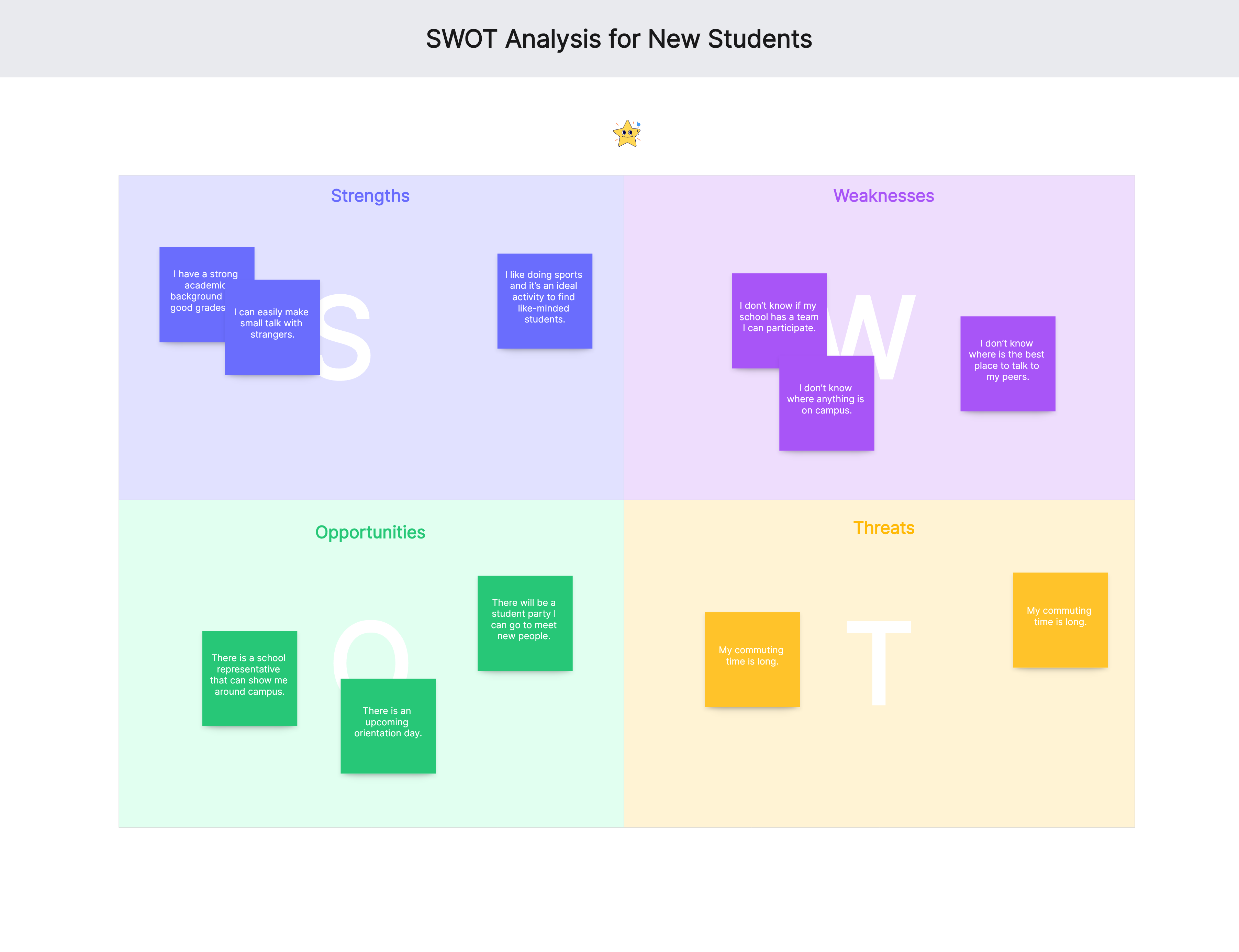
- I have a strong academic background and good grades,
- I can easily make small talk with strangers,
- I like doing sports and it’s an ideal activity to find like-minded students.
- I don’t know if my school has a team I can participate,
- I don’t know where anything is on campus,
- I don’t know where is the best place to talk to my peers.
Opportunities
- There is a school representative that can show me around campus,
- There is an upcoming orientation day,
- There will be a student party I can go to meet new people.
- My commuting time is long,
- My schedule will be too tight and I might not have enough time to socialize.
#2 College Student SWOT Analysis Example
One of the personal SWOT analysis examples for students is that of the college student. This one deals with someone that tries to improve their academic performance and gain top grades.
What is your goal? I want to improve my grades.
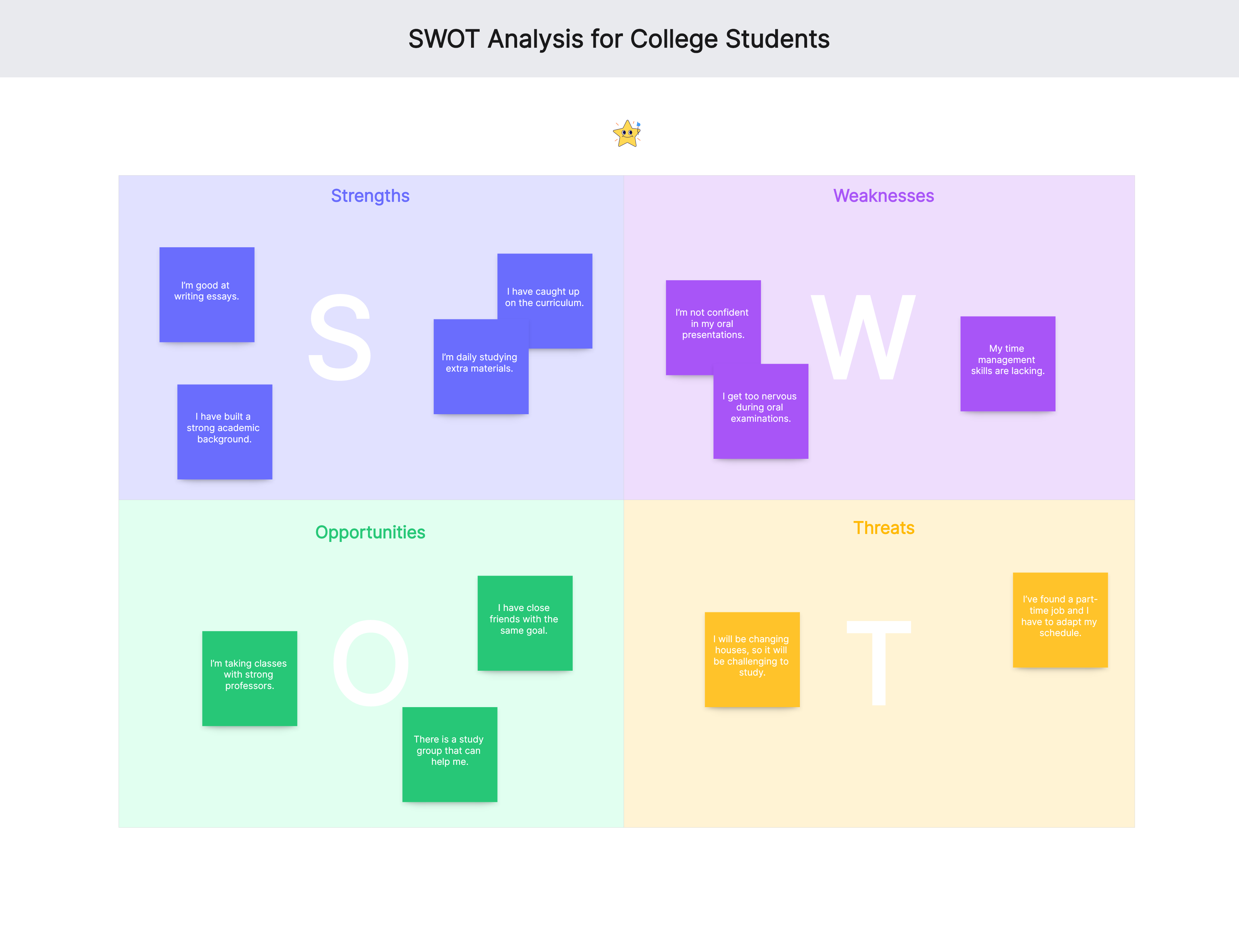
- I’m good at writing essays,
- I have built a strong academic background,
- I have caught up on the curriculum,
- I’m daily studying extra materials.
- I’m not confident in my oral presentations,
- I get too nervous during oral examinations,
- My time management skills are lacking.
- I’m taking classes with strong professors,
- There is a study group that can help me,
- I have close friends with the same goal.
- I will be changing houses, so it will be challenging to study,
- I’ve found a part-time job and I have to adapt my schedule.
#3 Exchange Student SWOT Analysis Example
One of the SWOT analysis examples for students that you will find is the one of exchange students. This particular example shows the challenges and opportunities they are facing.
What is your goal? I want to make the most out of the exchange program.
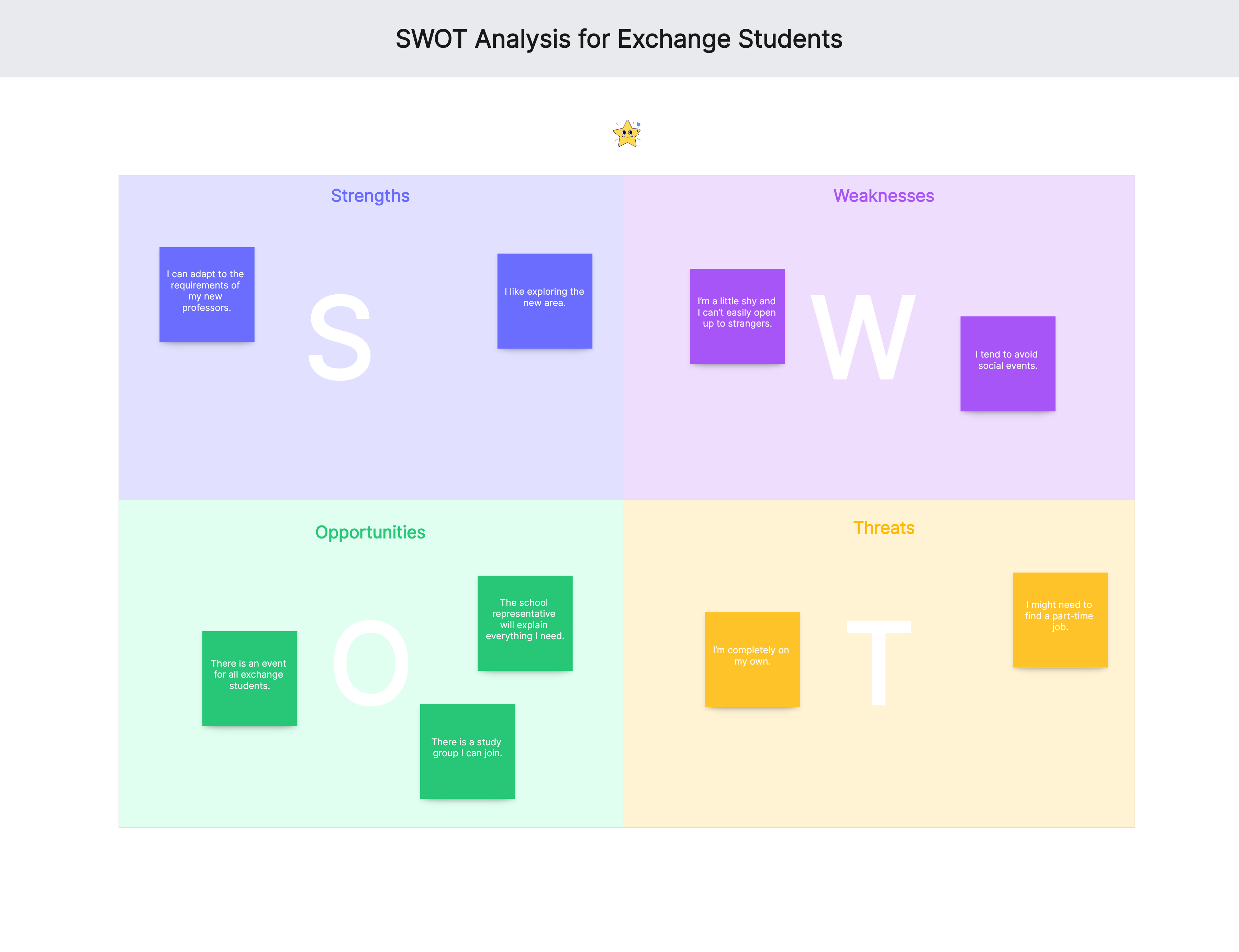
- I can adapt to the requirements of my new professors,
- I like exploring the new area.
- I’m a little shy and I can’t easily open up to strangers,
- I tend to avoid social events.
- There is an event for all exchange students,
- There is a study group I can join,
- The school representative will explain everything I need.
- I’m completely on my own,
- I might need to find a part-time job.
#4 High School Student SWOT Analysis Example
If you search for SWOT analysis examples for students, then you will definitely find one for a high school student. In this instance, the goal is to prepare for the future.
What is your goal? I want to find out which college I want to attend.
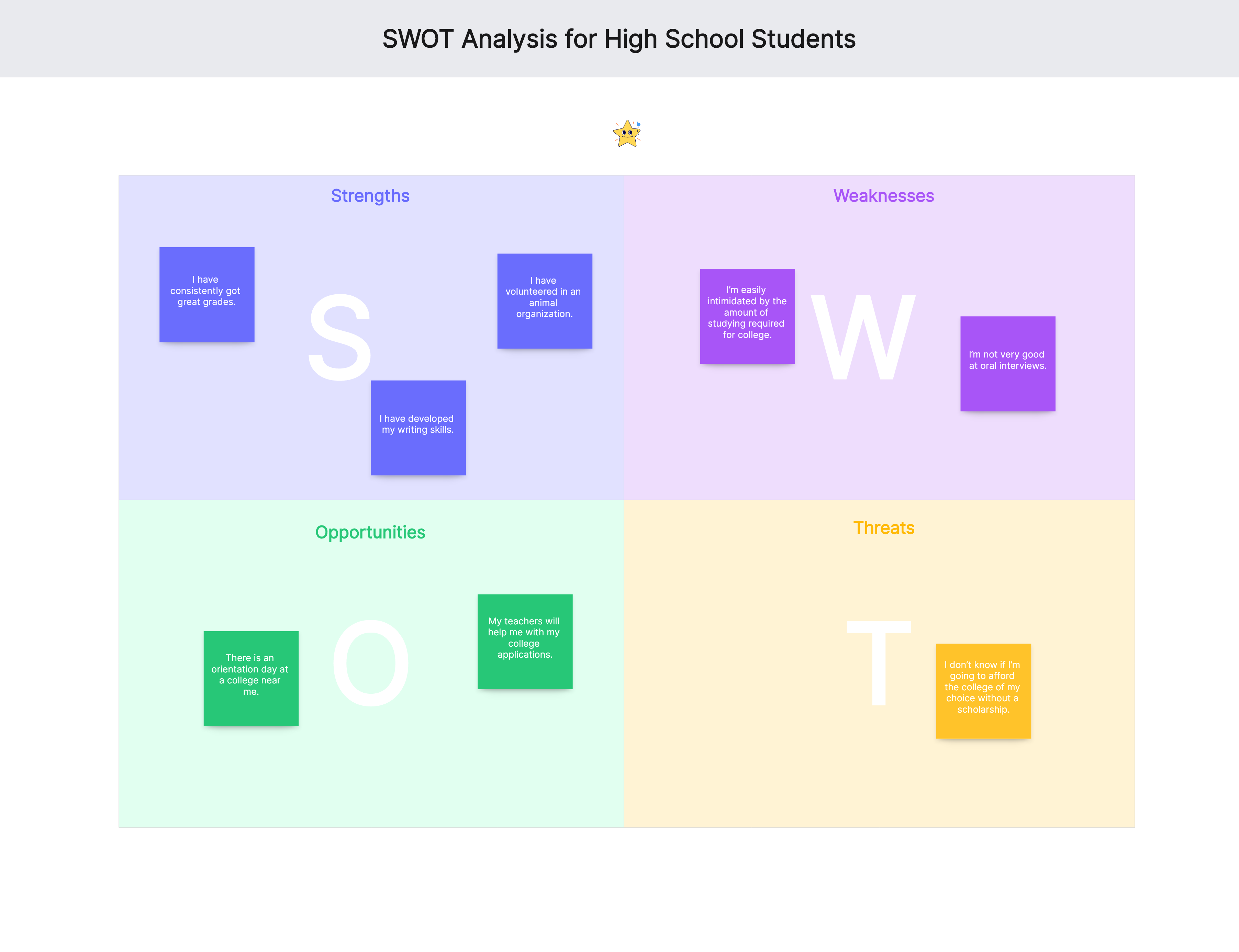
- I have consistently got great grades,
- I have volunteered in an animal organization,
- I have developed my writing skills.
- I’m easily intimidated by the amount of studying required for college,
- I’m not very good at oral interviews.
- There is an orientation day at a college near me,
- My teachers will help me with my college applications.
- I don’t know if I’m going to afford the college of my choice without a scholarship.
#5 Master’s Degree Student SWOT Analysis Example
One of the personal SWOT analysis examples that you are going to find very helpful is that of a master’s degree student. In this case, the student already has a strong academic background.
What is your goal? I want to complete my master’s degree.
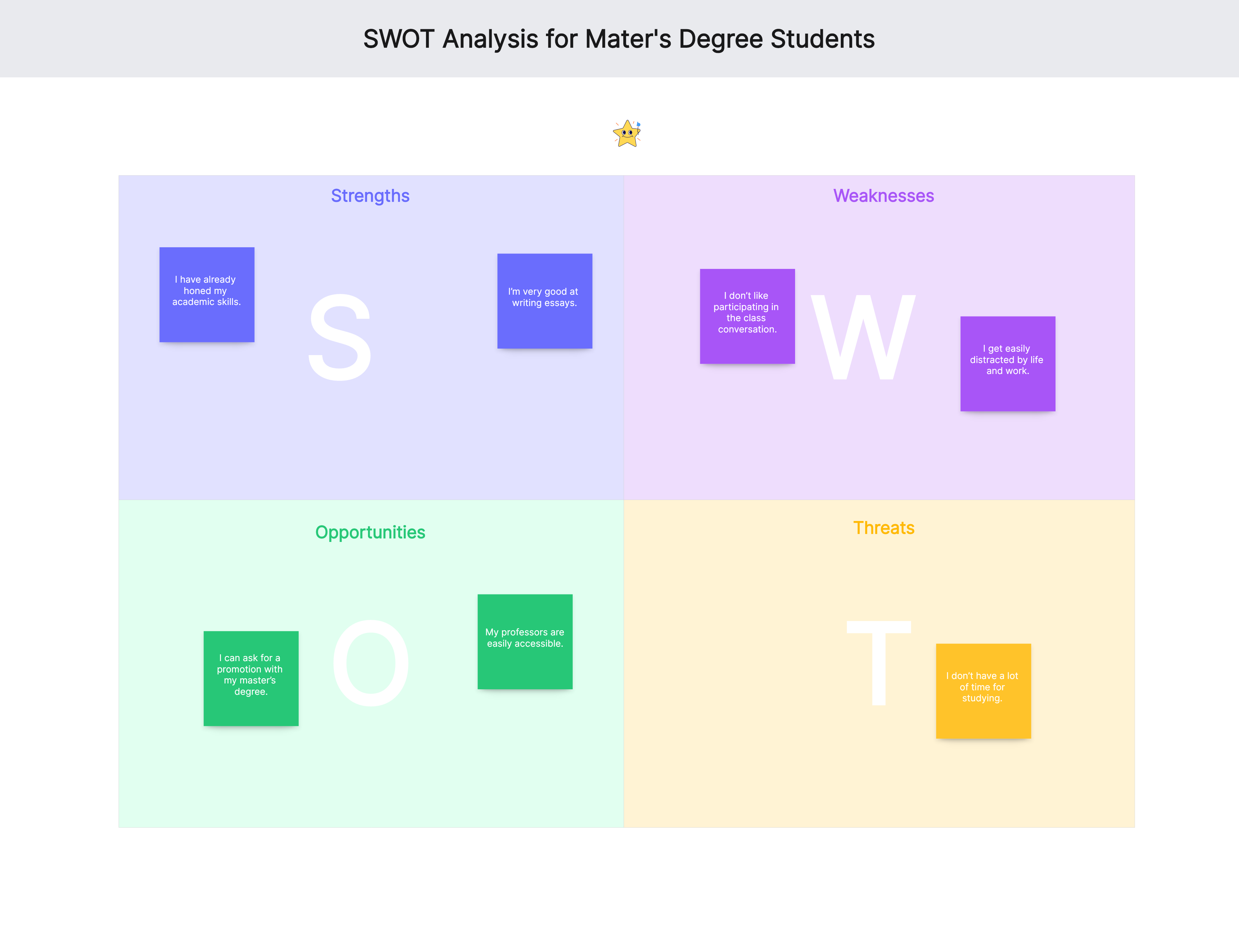
- I have already honed my academic skills,
- I’m very good at writing essays.
- I don’t like participating in the class conversation,
- I get easily distracted by life and work.
- I can ask for a promotion with my master’s degree,
- My professors are easily accessible.
- I don’t have a lot of time for studying.
#6 Graduating Student SWOT Analysis Example
Some other SWOT analysis examples for students focus on those are currently graduating. These examples try to show the challenges they have while trying to find a job.
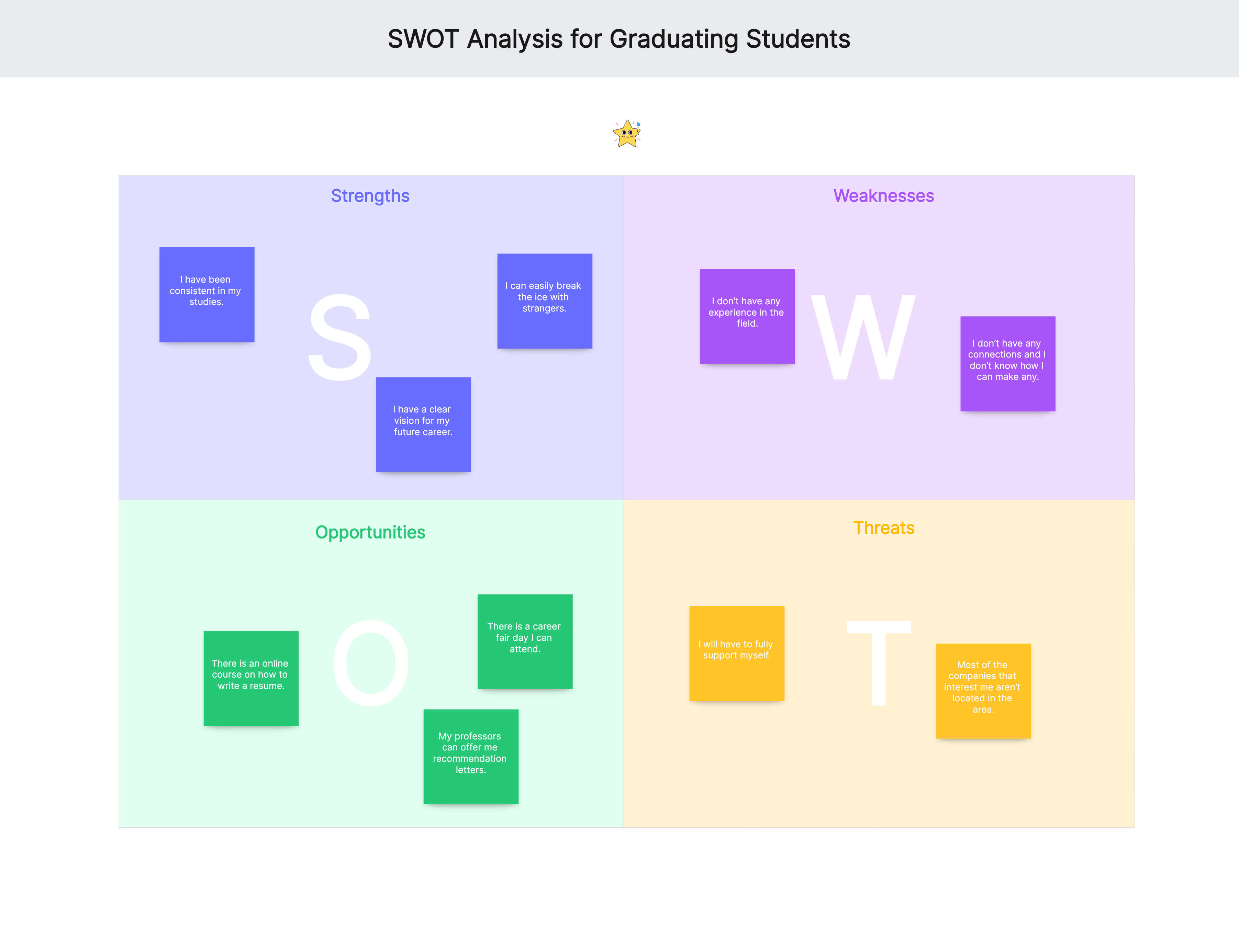
What is your goal? I want to find an entry-level job that suits me.
- I have been consistent in my studies,
- I can easily break the ice with strangers,
- I have a clear vision for my future career.
- I don’t have any experience in the field,
- I don’t have any connections and I don’t know how I can make any.
- There is an online course on how to write a resume,
- There is a career fair day I can attend,
- My professors can offer me recommendation letters.
- Most of the companies that interest me aren’t located in the area,
- I will have to fully support myself.
#7 Groupwork SWOT Analysis Example
Some other SWOT analysis examples for students focus on the challenges of groupwork. This is something that all students will have to face, and so this example will be useful to you.
What is your goal? I want to make this cooperation successful.

- I can offer my research skills to the team,
- I’m great at organizing the team,
- I already know most members of the team.
- I’m not good at time management,
- I’m not as familiar with the topic as other members.
- The library has a great selection of sources.
- We might disagree on how to do the presentation,
- We will have to find a place to study all together.
#8 Academic Performance SWOT Analysis Example
One more example that will be invaluable to you is a SWOT analysis of your academic performance.
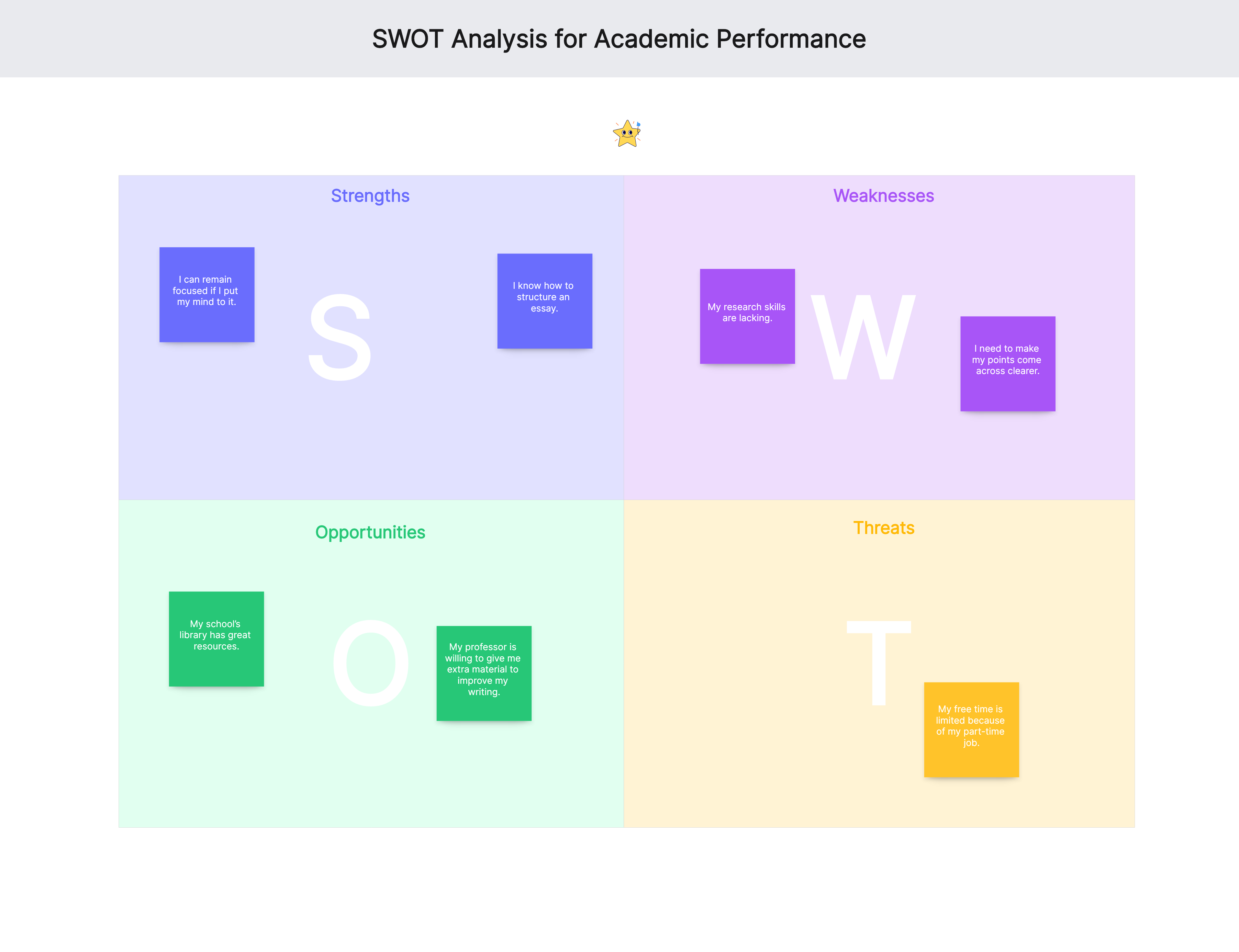
- I can remain focused if I put my mind to it,
- I know how to structure an essay.
- My research skills are lacking,
- I need to make my points come across clearer.
- My school’s library has great resources,
- My professor is willing to give me extra material to improve my writing.
- My free time is limited because of my part-time job.
The Bottom Line
All of these are SWOT analysis examples for students that you can use as inspiration to make one for your case. In Boardmix , you will find plenty of templates, which you can easily edit depending on your needs. The free SWOT Analysis template provides a pre-structured format, which saves time as you don't have to create one from scratch, and ensures you don't overlook any important aspect of the analysis. Create your account to gain the benefits of a personal SWOT analysis!

Harness the Power of SWOT Analysis for Effective Decision-making
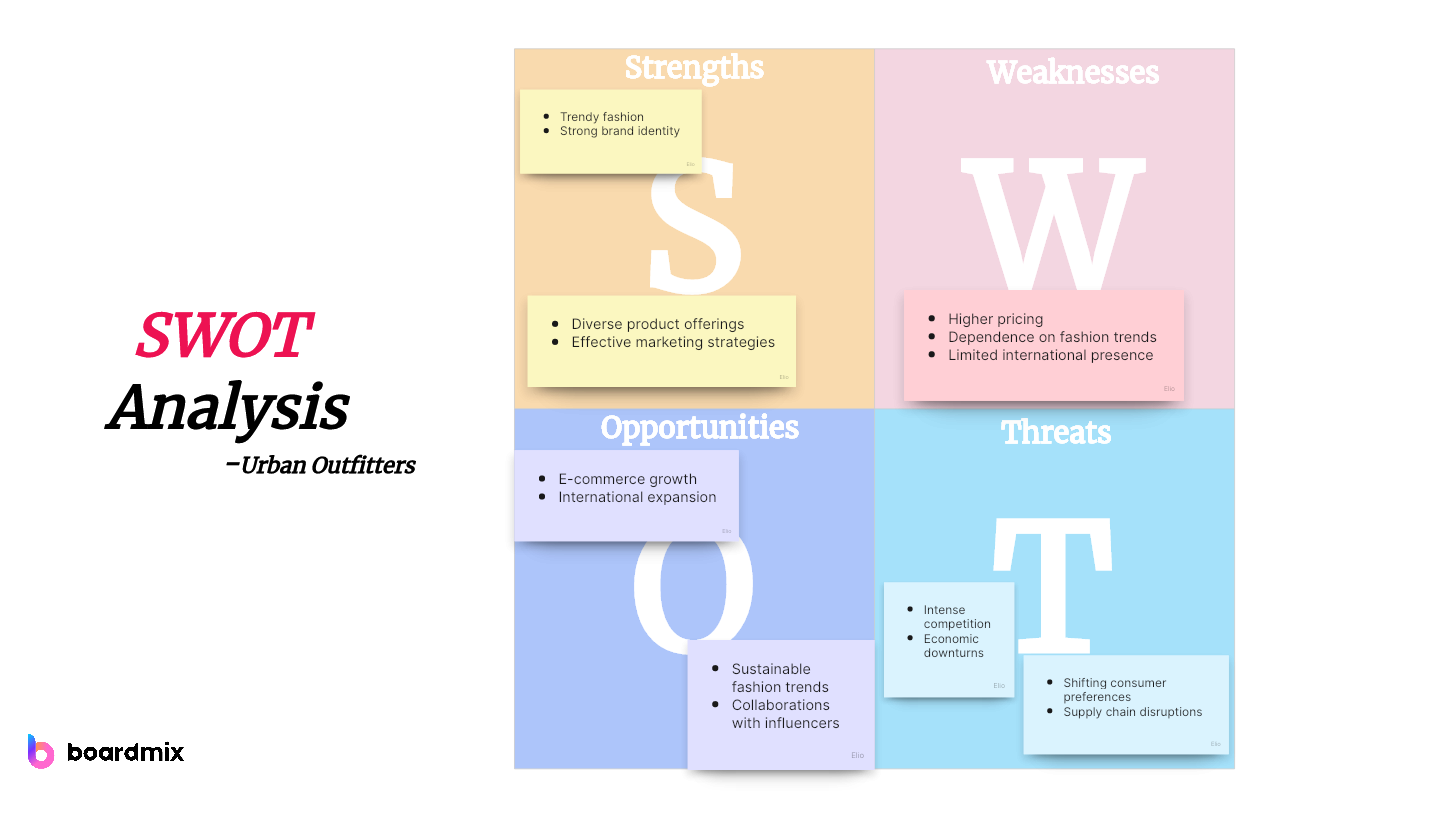
A Deep Dive into SWOT Analysis of a Business
![swot analysis essay for students A Comprehensive Guide to SWOT Analysis for Teachers [with Examples]](https://cms.boardmix.com/images/articles/swot-analysis-for-teachers-cover.png)
A Comprehensive Guide to SWOT Analysis for Teachers [with Examples]

🧮 SWOT analysis Essays
Company description and swot analysis.
NAB Company Name and its Significance The name of the company is Victorious Drink of Gods and Goddesses. The Special brewed drink consists of all…
Tesla Business Analysis
Tesla is an American Company that manufacturers high-end electric vehicles, solar panels and also provide energy storage solutions. The company’s history can be traced back…
SWOT Analysis – Tesla Motors
Strengths Tesla Motors is an American electric automotive company and holds a large market share in the American electric vehicle market. The company is flourishing…
A2 (200) Organizational Strategy
SWOT Analysis Questions Writing a SWOT analysis involves focusing on both strengths and weaknesses of a company, as well as its opportunities and threats in…
Pestle Analysis of Lego
Environmental analysis occupies a significant position in the strategic management process (Swayne, Duncan & Ginter, 2012). It helps a company to analyse the factors affecting…

Audience analysis
The company To accurately identify the current audience of the company, it would be necessary to determine the company, the nature of its business, the…
Analysis of the Three Markets
Summary Due to the high rise in completion, it has become critical for an organization to analyze and monitor their external marketing environment (macro-environment) that…
UK Footwear Industry
Porter 5 Forces Analysis of UK Footwear Industry Barrier to entry Entry into the UK footwear industry is highly minimized through high entry barriers. According…
The city of London
Background Money laundering is a plague that must be eradicated from the city of London at all cost. Over the past few years, residents, as…
Management Strategy of Wells Fargo
Abstract The report is based on one of the largest banks of America, Wells Fargo. Some of the bank’s strengths include wide distribution channel, cross-selling…
A competitive advantage approach and concepts
Question one SWOT analysis as a strategic planning tool The acronym stands for strength weaknesses opportunity and threats. The use of SWOT analysis involves a…
Marketing strategy recommendations
Background Summary The aim of this report is to give a detailed marketing strategy that Nicole’s business (50@50 books) will implement to reach her readers….
Human resource strategies and practices
Netflix Competitive Strategy Netflix has evolved to become a key player in the DVD rentals and video streaming industry. The success of the firm in…
Market-oriented mission statement
Traditionally many businesses utilize product-oriented mission statements. There is far much less utilization of market-oriented mission statements. Market-oriented mission statements focus on the needs of…
Business memo
The competitive profile matrix premised its analysis on fifteen critical factors that were critical determinants for the success of the three firms in State College…
Internal Environment of British Airways
The company selected for analyzing the business environment is British Airways. British Airways (BA) is the largest airline as per fleet size in the United…
Understanding concepts of strategy in business and war
Without strategy, war would be nothing but chaos and death, a game of chance in which survival depends on luck. This may well have been…
Thomas Cook: a strategic analysis
Introduction The package holiday industry is worth millions of pounds and it is common for every country to have a few dominant tour package service…
Marketing trends of major players in café industry
Over the Past few years, Australians shifted towards a more affluent lifestyle brought about by the country’s good economic performance. The strong performance of the…
History Will Keith Kellogg (W.K.) began his cereal-making career in the 1890’s when he assisted his brother, Dr. John Harvey Kellogg, in creating foods for…
What is the best site to search for quality SWOT analysis paper samples?
It’s undoubtedly Grademiners for its qualitative work and high reputation on the web.
How to use SWOT essay samples to create my own paper?
You may use our samples as a self-help guide to cover your idea and content organization shortages. Moreover, templates contain relevant data, so use them for your bibliography.
Is it allowed to submit your samples as mine?
It’s not advisable to hand in our samples as yours. Instead, use them primarily as a reference or source of inspiration.
How many college paper and essay samples do you have in your directory?
You can find thousands of high-quality essay examples on various topics in our database.
People make hard decisions daily as individuals or as part of a company or large corporation. However, only applying a good strategy to take action makes it possible to achieve success. A SWOT essay example is for students to develop critical thinking and look at a situation from four angles. Our rich database contains topics to help you understand the value behind the following decision-making technique.
Essay on SWOT Analysis: Significance of Strategic Planning
All wealthy business owners state their strengths and weaknesses, potential opportunities, and threats. It means that they are aware of SWOT analysis. It is commonly applied in market management who want to boost their revenue and lead the industry. The analysis goal is to indicate an organization’s harmful and helpful factors.
Students who write an essay about SWOT analysis may struggle most in investigating economies of scale. Moreover, they may need to conduct well-around research on various successful big and small enterprises. Besides the time-consuming prewriting process, it also takes a thorough understanding of academic writing.
SWOT Analysis Essay Examples to Tap
Let’s explore together how to use an example of SWOT analysis paper as a tool to craft an essay from the ground.
Develop Exciting Ideas
College students may need some relevant resources for research. Grademiners’ trustworthy database presents appealing templates to motivate you. Run through several samples and generate fascinating ideas to create a topic engaging for your reader.
Learn Formatting Rules
An academic essay has a precise format that students need to abide by. Each SWOT analysis essay sample reflects a standard structure that students must stick to fulfill the profound requirements. So, create your outline based on them to achieve a desirable result.
Check the Quality Work of Writers
Our qualified team spares no effort to develop a top-notch SWOT paper example database for your credit. All you get to do is to read it, assess the talent of our writers and editors, and benefit from it to your heart’s content.
Employ Ready-Made SWOT Analysis Paper Example or Order a New One
We have an optimal solution for you if you feel on a treadmill and find yourself unable to handle your writing. We offer to take the plunge and submit your order details right now. Our writers will comply with your instructions and deliver your paper right on time.
- Business Ethics
- Business Law
- Career Path
- Entrepreneurship
- International Business

- Corporate Courses |
- Employee Courses |
- Leadership Courses |
- Limited Time Offer

Step-By-Step SWOT Analysis Classroom Activity Guide
Insightful and practical? Honestly, it’s the dream guide you need.
Chances are you’ve spent hours looking for a classroom activity guide on how to do a SWOT Analysis?
We’re talking a hidden gem that will help you achieve everything that you want to achieve within an easy-to-replicate activity.
You’ve come to the right place.
A SWOT analysis is a powerful strategic planning tool that helps individuals and organizations assess their internal strengths and weaknesses, as well as external opportunities and threats.
In a classroom setting, conducting a SWOT analysis can be an engaging and insightful activity to foster critical thinking, teamwork, and self-awareness among students.
This guide provides step-by-step instructions on how to facilitate a SWOT analysis classroom activity.
Objective: The primary objective of this activity is to help students analyze a particular subject or topic from different angles, understand its strengths and weaknesses , identify potential opportunities and threats, and develop recommendations for improvement.
Materials Needed:
- Whiteboard or chalkboard (or any display tool)
- Markers or chalk
- Flipchart or large sheets of paper
- Sticky notes
- Handouts with guidelines and templates (optional)
Step-by-Step Guide:
Practical activities for classroom settings don’t have to involve complicated and long-winded solutions.
Sometimes all you need is a step-by-step process to make you feel confident in what you are doing and that will guarantee you’ll find something that’s just right.
Introduction to SWOT Analysis: It’s always a good idea to begin the activity by explaining the concept of SWOT analysis to the students.
In this case, you should briefly describe what each component represents:
- Strengths : Internal factors that give an advantage.
- Weaknesses : Internal factors that hinder progress.
- Opportunities : External factors that present favorable circumstances.
- Threats : External factors that pose challenges or risks.
Next, you can build momentum by detailing the steps involved. To illustrate:
- Selecting a Topic: Choose a relevant topic for the SWOT analysis activity that aligns with the curriculum or current lesson plan. It could be a historical event, a literary work, a scientific concept, a business case study, or any other subject of interest.
- Forming Groups: Divide the class into small groups of 4-5 students. Diversity in each group can be beneficial to gather different perspectives.
- Conducting the SWOT Analysis: Distribute the materials, including sticky notes and markers, to each group. Ask them to label four separate sheets of paper with “Strengths,” “Weaknesses,” “Opportunities,” and “Threats.”
- Brainstorming Session: Instruct each group to brainstorm and write down their ideas under the corresponding categories. Encourage them to be specific and provide evidence or examples to support their points.
- Presentation: After the brainstorming session, have each group present their SWOT analysis to the rest of the class. They can use the whiteboard, chalkboard, or flipchart to display their findings visually.
- Group Discussion: After each presentation, facilitate a discussion among the students. Encourage questions, comments, and constructive feedback from the other groups. Discuss any differences in perspectives, instructional strategies , and insights gained from the activity.
- Recommendations: Instruct each group to come up with recommendations based on their SWOT analysis. They should focus on utilizing strengths, addressing weaknesses, capitalizing on opportunities, and mitigating threats.
- Sharing Recommendations: Have each group share their recommendations and action plans for success with the class. Discuss the feasibility and potential impact of these recommendations.
- Conclusion: Wrap up the activity with a brief summary of the key takeaways from the SWOT analysis. Emphasize the importance of understanding strengths, weaknesses, opportunities, and threats when making informed decisions and developing strategies.
As an extension to the activity, students can develop action plans based on their recommendations and present them to the class or relevant stakeholders. Equally, you can provide handouts with guidelines and templates to help students structure their SWOT analysis if needed.
Remember, the SWOT analysis classroom activity should be an interactive and inclusive learning experience, fostering collaboration, critical thinking, and creativity among students.
To discover more about how our training course materials can help you to increase learner engagement, provide effective training courses, and extend your team’s knowledge, please take a moment to review our frequently asked questions , special offers , and training course material .
Mastering SWOT Analysis: A Step-By-Step Guide
Uncover Your Strengths & Weaknesses With A Personal SWOT Analysis
Discussing Strengths And Weaknesses: A Guide For Job Interviews
Explore 8 Most Effective Instructional Strategies for Successful Learning
Discover 9 Instructional Strategies For Lifelong Learning
Understanding The Power Of Smart Objectives
10 emotional intelligence activities for teams.

Special Offer - 75% Reduction
Need to run more than a one or two courses?
You’ll save so much time with a complete course solution that makes it easy for people to run their own courses.
Get instant access to all 52 sets of training course materials for just $15.00 per course.
That’s 75% off regular prices .
Trusted By Leading Commercial And Public Sector Organizations.

There’s Always More Learning To Explore.

Buy Quality Management Skills Workbooks

Buy Corporate Structure Skills Workbooks

Buy Issues In An Organization Workbooks

Buy Corporate Culture Skills Workbooks

Buy Negotiation Skills Workbooks

Buy Marketing Skills Workbooks

Buy Conflict Resolution Skills Workbooks

Buy Leadership Influence Skills Workbooks

Buy Delegation In Leadership Workbooks

Buy Leadership Skills Workbooks

Buy Job Design Skills Workbooks

Buy Job Analysis Skills Workbooks
Frequently asked questions..
Oak Innovation simplifies the course creation process. Our training course material will save you time. And, you'll get instant access to the training content needed to meet the needs of your audience.
You don’t need to be an present our training course material – simply focus on your course delivery, and we’ll handle the rest. You get instant access to workbooks, guides, and resources.
Our pricing is really simple. Each set of course material costs $60.
1. Select the course you want to deliver. 2. Add the course materials to the cart. 3. Securely pay using all major cards. 4. Get instant access via a secure download. 5. Get an email with download instructions. 6. Unzip to access everything in MS Office.
Yes. You can add your logo and brand the course material as your own.
Yes, you can see a full list of our courses in our shop .
This training course material can be used to teach all categories of employees. Senior Leadership Teams - Leadership teams play a critical role in organizations. These course materials will equip them with the skills needed to transform their companies into the future. Mid-Level Managers, Supervisors And HR Professionals - The training course material enable mid-level managers, supervisors and HR professionals to lead and develop their teams for success. Frontline Employees - Core to all organizations, frontline employees will benefit directly from these training course materials. Small Business Owners And Entrepreneurs - Attending courses based on these training course materials will equip all entrepreneurs and their teams with the skills, knowledge and abilities required to revolutionize their companies.
Which Training Course Materials Are Right For You?

- Essay Editor
Swot Analysis Essay Examples & Topics
- Bussiness Plan
- Entrepreneurship
- International Business
- Organization
Heineken Lager Beer: SWOT Analysis Essay
1. Introduction The Heineken Company was founded in 1864 in Amsterdam, but has now become a recognized brand in 170 countries. It is the number one brewer in Europe and the number three brewer by volume in the world. Heineken makes many of the world's largest brands of beer and is known for a strong brand that is sold in many outlets. Currently, the company has over 125 breweries in more than 70 countries, and employs approximately 57,557 people. The beer that bears the company's name is the nu ...
External Audit for Strategic Management Report
1. Introduction The purpose of this report is to create a detailed analysis on the effectiveness of a company in its strategic actions. Two companies will be the main focus in this report, those being Lion Nathan and Foster's Group. A number of strategic management concepts will be reviewed in relation to their effectiveness for the chosen companies. These concepts include decision-making theory (rational, adaptive, and intuitive), internal and external analysis, SWOT analysis, and comparing th ...
Strategic Planning of Starbucks
1. Introduction It is rare to find a business of any size or age that has not engaged in some form of planning. The company discussed in this paper is no exception; Starbucks, the world's largest multinational chain of coffee shops, has a long history of success, having been in business for over two decades. However, in light of new competitors in the industry and an increasingly tightening economic environment, Starbucks has been forced to consider new strategies in order to maintain a competi ...
Pluto Telecommunications Case Study
1. Introduction 1.1 There is a clear business objective of increasing revenue by 10%, and Pluto is aware that if they are unable to identify the key issues preventing them from maintaining $120 million in revenue, they will not achieve their target. To understand why revenue is declining, it is important to identify how Pluto has reached this point. Any recommendations made in the report will be specific to issues identified from the case study data and may not be attributed to issues that have ...
Oracle HRIS Software Strengths and Weaknesses Report
1. Introduction Oracle HRIS software refers to the configuration of HR software to cater to the requirements of a multinational organization. Global groups have complex requirements in terms of HR software to cater to a diverse set of employees located in different parts of the world. Oracle HRIS suite is designed to cater to these complex multinational requirements and provides a scalable solution in terms of globalization. The purpose of this report is to provide an insight into different str ...
Sony Ericsson Company Strategic Management Essay
1. Introduction Sony Ericsson is a company that is famous for its mobile phone technology. It is a joint venture established on Oct 1, 2001, by the Japanese company Sony and the Swedish company Ericsson to make mobile phones. The initial period of the company, Sony's contribution to the JV was 3 billion euros in cash. This amount was mainly used to fund the activities of the company as during the start-up phase; Sony Ericsson relied on Ericsson's infrastructure and other assets such as building ...
SWOT Analysis and Intensive Growth Strategies, H&M Essay
1. Introduction 1.1 Background of H&M H&M is a Swedish retail clothing company known for trendy, affordable apparel. The fast-fashion industry is typified by firms that use the most cost efficient means to provide a current fashion product. This has created a gap in the market for H&M to continue with its unique approach that offers current, trendy, high fashion items at prices the masses can afford. H&M has experienced a healthy growth in sales with a 26% increase in 2007 compared to the previ ...
Dyson Company's Marketing Strategy Research Paper
1. Introduction James Dyson serves as patron of the UK Design Council. In May 2010, Dyson composed a paper for the UK government on the importance of innovation in rebalancing the economy. He argued for the vital importance of engineering and one of the key examples he provided was his own experience of developing a new technology product. Dyson contrasted the approach taken by the UK and China in supporting the development of technology industries. He asserted that the UK was in danger of losi ...
Nike Strategic Management: The Case Study Essay
1. Introduction Nike is the biggest and most prosperous sportswear market company on the globe. It centers on the sale of athletic shoes, sportswear, and clothing and is a multinational corporation located in the United States. The company was firstly founded in 1964 by Bill Bowerman and Philip Knight in Oregon and renamed to Nike in 1971. The name Nike was derived from the Greek Victory Goddess. In fact, the first shoe to have the swoosh was the football boot, which was the king of all footbal ...
Directional Strategies and Strategic Alternatives Case Study
1. Introduction Consider IGI's (Institute for Global and International Studies) expansion strategy. IGI was looking at expanding into new geographic markets to enhance their global network. Since maximizing your network is in line with your strength, it shows you that you will be able to leverage your resources and capabilities to take advantage of opportunities. Consider IGI's (Institute for Global and International Studies) expansion strategy. IGI was looking at expanding into new geographic ...
Starbuck's strategic plan
1. Introduction The company which I have chosen to do my strategic plan is Starbucks Coffee Company. The reason I have chosen Starbucks is because of its rapid expansion and two other reasons. Firstly, I am a coffee lover and I am attracted to the different types of coffee which Starbucks has to offer. Secondly, Starbucks is a reputable company and has so far done well in the last few years in terms of its sales and revenue. However, as Starbucks is moving ahead in terms of its sales and revenu ...
External and Internal Analysis of Starbucks: Case Study
1. External Analysis Starbucks Corporation is an international coffee and coffeehouse chain based in Seattle, Washington, United States. It opened as a single small store in 1971 and became a coffee giant at the end of the millennium. As the world's number one specialty coffee retailer, Starbucks sells coffee drinks, food items, coffee beans, and coffee-related accessories and equipment. In addition, Starbucks sells whole-bean coffees through a specialty sales group and grocery stores. Starbuck ...
Strategic Marketing of Tim Horton's Research Paper
1. Introduction Tim Hortons is one of North America's leading food service retailers focused on coffee and doughnuts. The first Tim Hortons restaurants offered only two products - coffee and doughnuts. The selection of doughnuts to enjoy with the coffee offer was highlighted by only two original Tim Hortons creations, the Apple Fritter and the Dutchie. Tim Hortons has progressed into a chain with more than 2500 variation stores in Canada and over 400 stores in the United States. 71% of the coff ...
SWOT Analysis and Intensive Strategies for Zara Essay
1. Introduction Zara is a Spanish clothing and accessories retailer based in Arteijo, Galicia, and founded in 1975 by Amancio Ortega and Rosalia Mera. It is the flagship chain store of the Inditex group; the fashion group also owns brands such as Massimo Dutti, Pull and Bear, Oysho, Uterque, Stradivarius, and Bershka. The group is headquartered in A Coruna, Galicia. Zara opened its first store in the coastal town of A Coruna in the northwest of Spain in 1975. Amancio Ortega Gaona, the company's ...
Company Analysis of Costcutter Supermarkets
1. Introduction The background to this study focuses on the concept of internationalisation, home replication, and cost pressures that modern organisations face, using these as a platform to analyze Costcutter Supermarkets. Internationalisation is the process of increasing commitment in operating in value-adding activities across national borders (Rugman, 2005). This concept is very relevant in the case of Costcutter as a decision has been made to change the UK management structure to group chi ...

IMAGES
VIDEO
COMMENTS
2. Personal SWOT Analysis Example. Goal: To gain confidence at university. Strengths. - I can confidently write information on paper to communicate a message to my teacher. - I know I am capable of achieving things when I put my mind to it. - I did well in high school and know that I am academically minded. - I know that I can study ...
While doing a SWOT analysis, students need not follow the same order of identifying strengths first, then weaknesses. Here is a process that students can follow to start. Identify Goals. Identify Strengths and Weaknesses. Identify Opportunities. Identify Threats. Prioritize. 1. Identify Goals.
Following are some of the greatest SWOT Analysis essay examples you can find on the web: SWOT Analysis on Merck & Co. Inc. Premier Inn: Key Strategic Issues, Porter's Five Forces, and SWOT Analysis. Silver Airways LLC SWOT and Strategic Goals.
This guide gives students a step-by-step way to write a SWOT analysis essay. First, you have to choose a topic and figure out what the strengths, weaknesses, opportunities, and threats are. Then, the guide helps you analyze and organize your info. It's important to connect what's happening inside and outside the topic when making ...
An Example of a Personal SWOT Analysis . An Example of a Business SWOT Analysis . Final Words. The humble but effective SWOT analysis will produce a detailed map of your current environment—its hills and valleys alike. Knowing how to write a SWOT analysis will provide you with the vantage point you need to choose a direction and blaze a trail ...
3. Pinpoint Your or Your Organization's Strengths. Now, it's time for the brainstorming session. If you're doing a SWOT analysis for a business, go with it: bring the right people to the table, virtual or not. It'll help you get a more objective, realistic, and complete matrix.
Example 1: Personal SWOT Analysis. Photo by Giulia Bertelli. This example is specifically tailored for students who want to assess their personal strengths, weaknesses, opportunities, and threats. It can be used for personal development, career planning, or even for academic purposes.
4. SWOT analysis examples for students. Be the first to add your personal experience. 5. Benefits of SWOT analysis for students. Be the first to add your personal experience. If you want to ...
Writing an essay on SWOT analysis is important for several reasons: 1. Understanding Strategic Planning: By writing an essay on SWOT analysis, students and professionals can gain a deeper understanding of strategic planning and how to effectively assess the internal and external factors that can impact the success of a project or business. 2.
Using the SWOT analysis, students often find their unexplored talents, hence giving them an edge to explore the right career path for them. It helps you extend your strengths and pinpoint your shortcomings on time. Once done, the doors for opportunities will start opening and you will emerge as a better person.
The SWOT matrix of an individual can help him/her to overcome the weaknesses highlighted in the SWOT analysis and avail the opportunities that are present.. Conducting a personal SWOT analysis can help college students since it can provide them with self-awareness, which will help them in their career and personal life.. A SWOT analysis for college students will highlight the strengths of ...
Abstract This article delves into the significance and application of SWOT analysis, a crucial tool for business, marketing, teaching and individual self-assessment. Originated in the 1960's by Albert Humphrey, SWOT, originally known as the SOFT analysis, evaluates strengths, weaknesses, opportunities, and threats of an entity, be it an organisation or an individual. While businesses employ ...
1. Taking Decisions. SWOT analysis importance can be felt while taking and making decisions. While using SWOT to solve issues, students can identify various factors before arriving at possible conclusions. 2. Goal Setter. SWOT analysis can be used to set goals in the life of a student.
These examples will help you understand how SWOT analysis can be applied in your academic and personal life. 1. Choosing a Career Path: Strengths: Strong communication skills, ability to work well in teams. Weaknesses: Lack of experience in the desired field.
The purpose of this analysis is to gain an insight of Dell Inc. Starting out providing general background information of the company. It also discusses an industry analysis and containing a SWOT (Strengths, Weaknesses, Opportunities, and Threats) table and analysis of the SWOT. Finally ending... Dell Swot Analysis.
8 SWOT Analysis Examples for Students. In this section, you will find several SWOT analysis examples for students to show you how to do it for your own goals. These personal SWOT analysis examples for students are about different cases to highlight their varied applications. And they are all made using the online whiteboard tool Boardmix.
An academic essay has a precise format that students need to abide by. Each SWOT analysis essay sample reflects a standard structure that students must stick to fulfill the profound requirements. So, create your outline based on them to achieve a desirable result. Check the Quality Work of Writers
StrengthsNEMI has an extensive portfolio of products. The company has healthy and tasty different flavors of tea available in teabags. Besides, the company produces products with…. SWOT analysis Management Marketing. View full sample. Subject: Business. Pages: 2. Words: 604.
Divide the class into small groups of 4-5 students. Diversity in each group can be beneficial to gather different perspectives. Conducting the SWOT Analysis: Distribute the materials, including sticky notes and markers, to each group. Ask them to label four separate sheets of paper with "Strengths," "Weaknesses," "Opportunities ...
Introduction: SWOT analysis is defined as special and beneficial technique (tool) which is used by individuals as well as organisations in order to analyse the strengths, weaknesses, opportunities and threats.it is also known as SWOT matrix (Team, n.d.). The elements (strength, weakness, opportunity, threat) are usually same to all SWOT ...
Published: April 4, 2024. 1. Introduction The Apple Inc.'s Porter's 5 Forces and SWOT for 2016 case study is a concise case study that covers an industry and company analysis of Apple Inc. This case study will show a student an objective example of an industry analysis, and a specific example of a SWOT analysis.
Education is an example of a competitive resource, knowledge is essential for success. My ability to advance and apply my education and knowledge in the field is a key to my personal success. I believe that others view my strengths as my social skills and my ability to adapt to situations. I agree that I do have strength in my adaptability ...
Keep in mind: This sample was shared by another student. Let us write you an essay from scratch. 450+ experts on 30 subjects ready to help; Custom essay delivered in as few as 3 hours; ... Aldi Swot Analysis Essay. Aldi SWOT Analysis: A Comprehensive Examination of the Supermarket GiantIntroduction:In today's highly competitive retail industry ...